
Datsun 240ZG – part 3
Continuing work on the Datsun 240ZG. It has been a long while since I last worked on the car model for my barn find. This will be slow going because there are so many parts in general and many of them will be functional parts. I’m also in no rush and want it to match my vision. These sorts of projects are not for the timid. Now I’m back to building, one step at a time. I’m still on page one (of 13).
I don’t know if any of you will build a model car, but I like to share tips in case someone stumbles onto my blog. Or, perhaps the tips will apply to other situations. One of the things I’ve done for this build is to mark tiny plastic bags to hold assembled parts when I have to know front, back, left or right. I also mark them with the step number so I can easily find what they are when needed later. There are a lot of smaller assemblies that get pulled in later, so it just makes sense to mark them and protect them as I go (I’ll worry about touch-ups later).
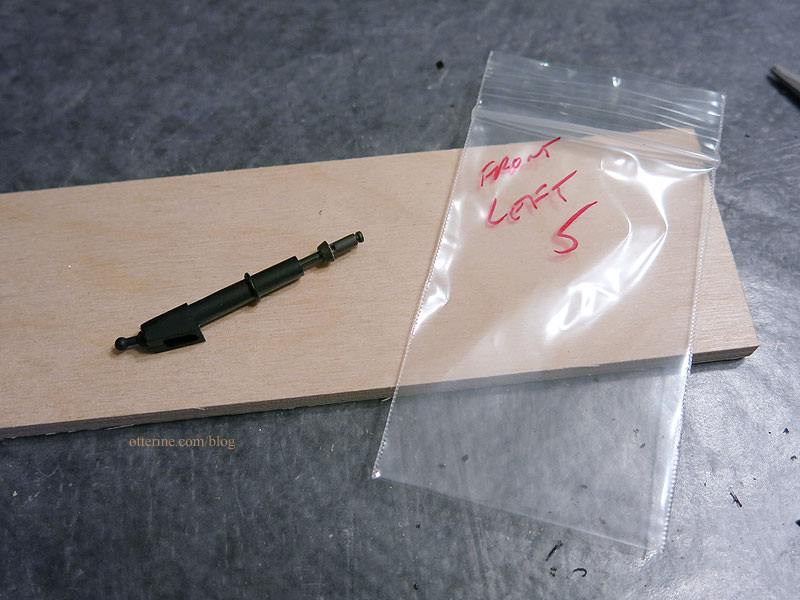
The other tip I have is removing that gleaming chrome finish from plastic model parts. There are several videos on the matter, and the easiest method involves household bleach. I stripped the bumper and the shock absorber parts mainly because I’ll be making the underneath a little aged and well used. Beyond that, the chrome bumper just looked like chrome coated plastic. :\ I will paint it to match the front bumper, which is grey metallic.
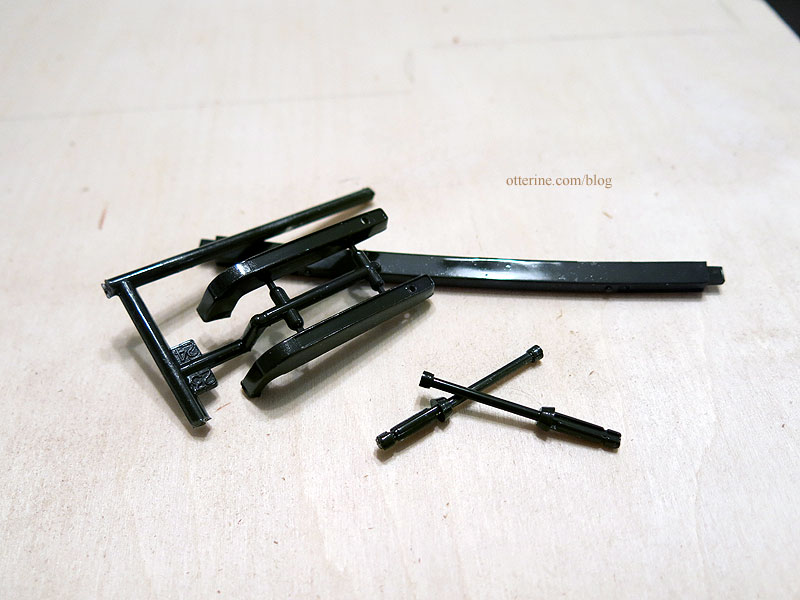
I watched the chrome disappear during the process, and the color went from high silver to yellowish to absent. This gave me an idea for the chrome wheel caps. =bling=
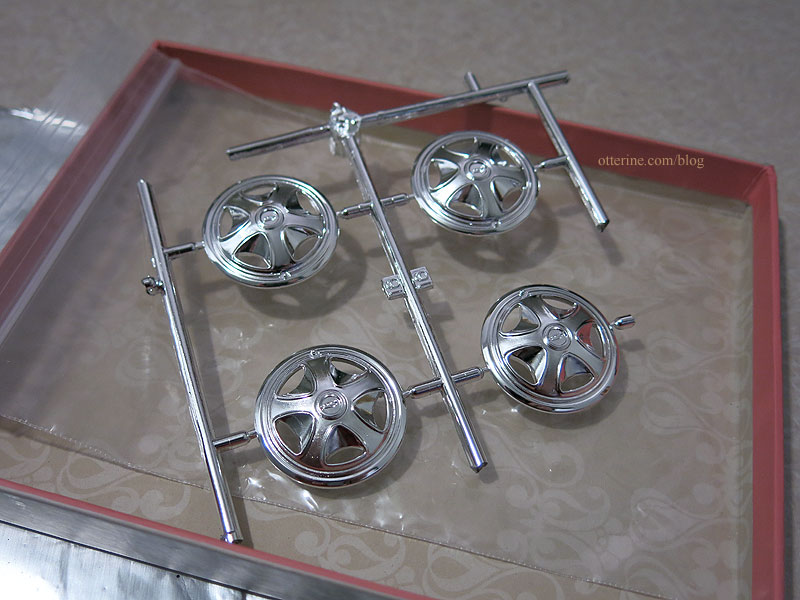
I soaked them until they turned slightly yellow.
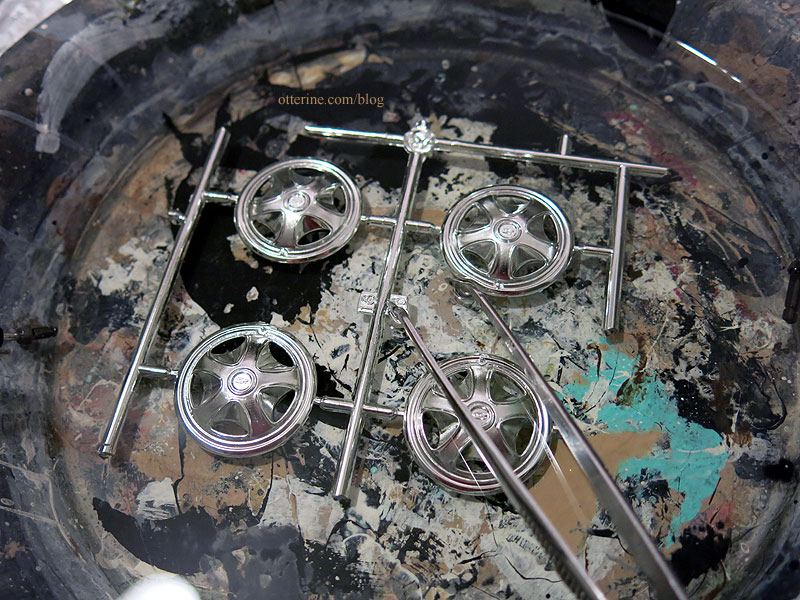
I don’t know if I will attempt painting these like the real deal, so this is a good compromise. Now they are less brilliant and yet still have good styling. It brought out the details actually, because it darkened the recessed lines by removing the finish in those areas. You can see the slightly yellow tinge next to the original parts. If the finish becomes unstable, it’s no worry to me…I can always paint them.
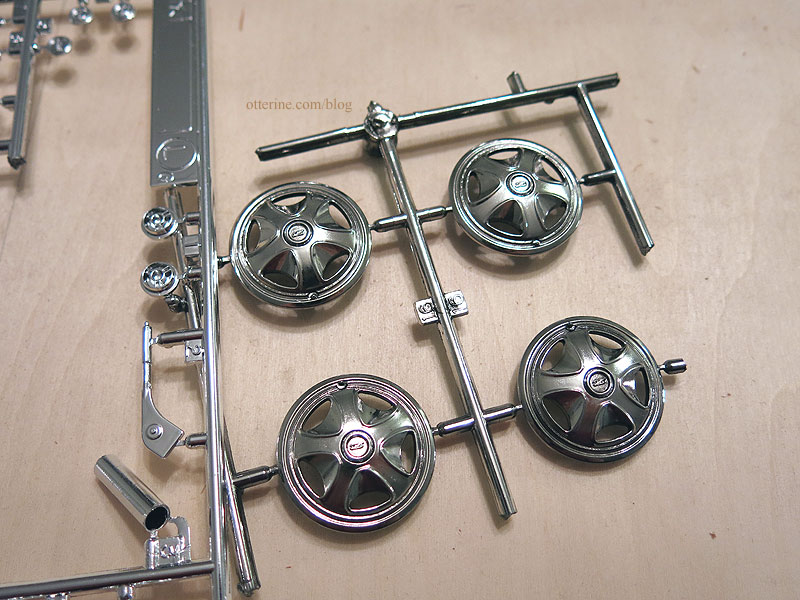
Removing chrome finish from plastic would definitely apply to the Chrysnbon bathroom kit. You could then paint the pipes and faucets any color you like. :] Or, you could do as I did and soak them a short time to weather them.
Categories: Milo Valley Farm, Model Cars, Vehicles
March 9, 2016 | 0 commentsTamiya tool set – part 2
Continuing work on the 1:12 scale Tamiya tool set. I’m starting with the polyethylene tank and oil jug. Here’s a reminder of what these looked like after assembly and initial sanding.


I primed them with grey spray primer and then followed that up with flat white spray paint. The grey toned down the white, which is good for a base to start aging.
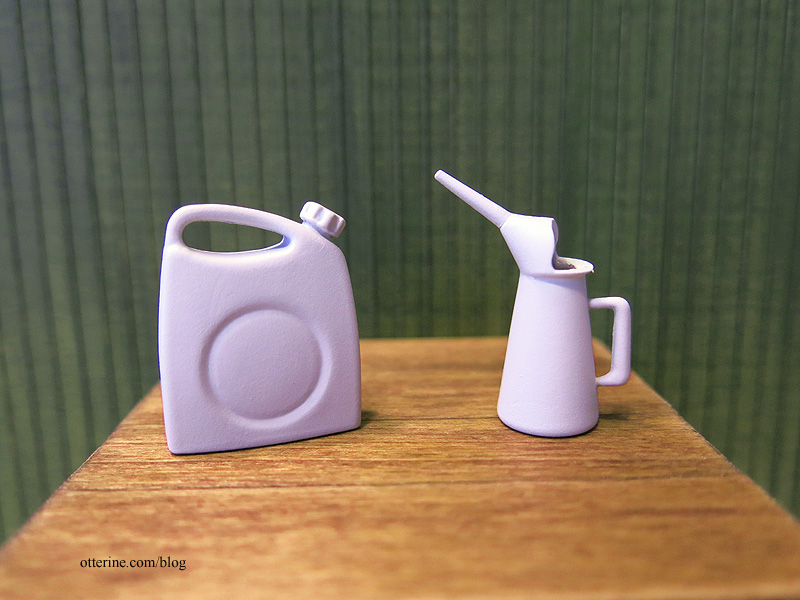
The vintage Texaco jugs I found online were all red, but I liked the white on the kit box, so I stuck with that. I painted the interior of the jug silver.

I added grime with acrylic paints thinned with Staining Medium. I left the decal whole when applying but scraped some holes from it after it dried in place. I also cut away the shiny clear portion around the outside of the decal as best I could. I put a dot of black paint at the tip of the spout to give the illusion of an opening.
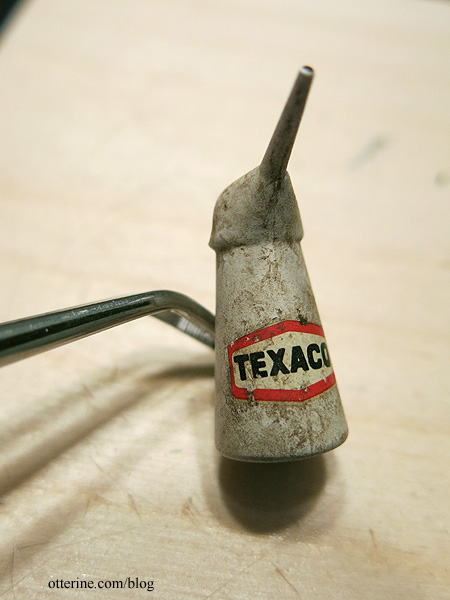
For the polyethylene tank, I added the same grime and painted the cap red. I mixed some of the grime paint wash with satin varnish. Using a tiny paintbrush, I made a dribble of dried liquid down the side.
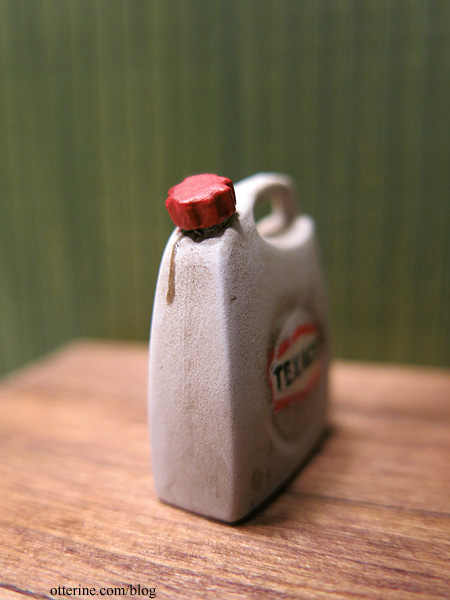
For these decals, I split them before applying so they appear broken and misshapen. I scraped holes and removed the clear halo from these as well.
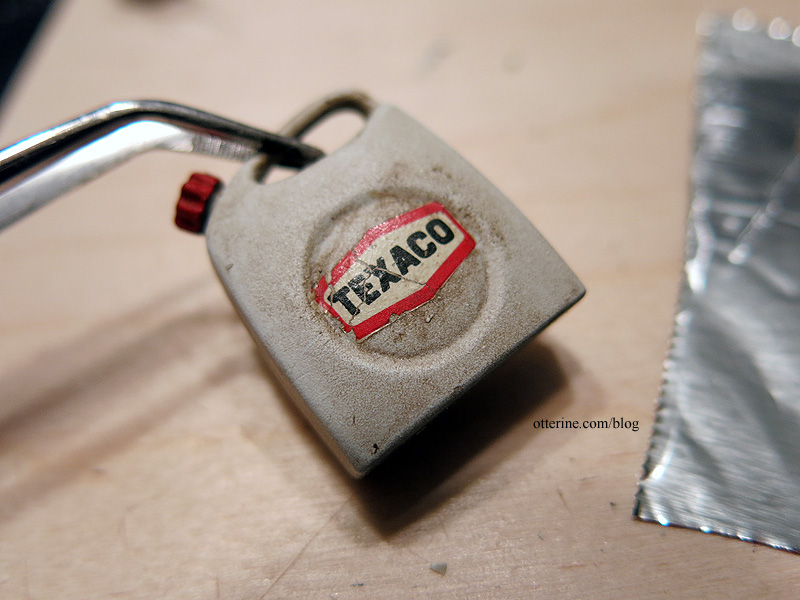
I built up the cracks in the label with white paint, followed by an aging wash to tone down the brightness. Now it looks like a paper label that has loosened, cracked and moved after getting wet.

I love the way they turned out.
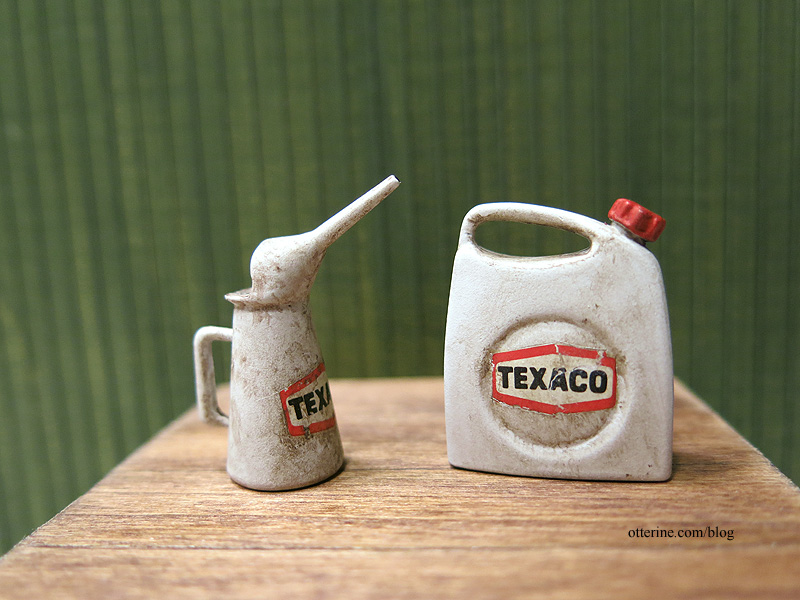
Categories: Miniatures, Model Cars, Vehicles
June 19, 2015 | 0 commentsTamiya tool set – part 1
I’ve started working on the 1:12 scale Tamiya tool set.
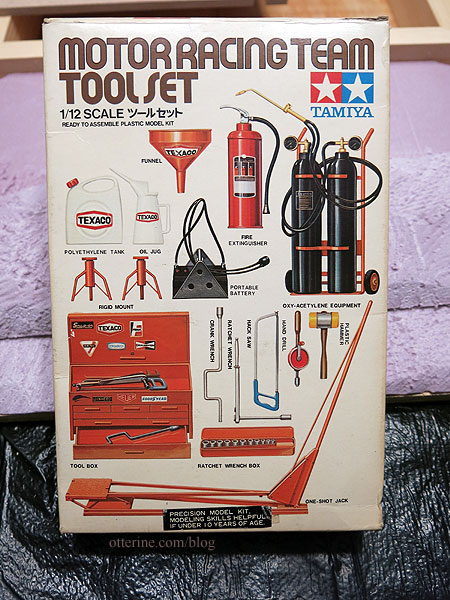
I might not make everything in the box, mainly because I already have better examples of these tools in metal and wood. The first bit of business is to remove the pieces from the sprue then sand or fill the imperfections.

Many of the pieces are assembled with glue, so I’ve done my best to fill in the joins. I won’t know how successful I’ve been until after I spray on the primer. :] They are obviously visible, but they feel smooth and might disappear under the primer.

I’ll likely age these pieces, so that will give me some flexibility.

Depending on how the cart for the oxy-acetylene torch turns out, I might remake it in metal for better realism and weight. I plan to paint the wheels separately, so they are not attached to the cart yet.

While I was at it, I’ve included the barrels from Bill. I’ve filled in a couple of holes in the red barrel with contour putty, which I will sand down once dry. I also removed the molded lines and injection marks. These have great detailing, so I hope the painting works out well.

Categories: Miniatures, Model Cars, Vehicles
June 9, 2015 | 0 commentsLicense plates in 1:12 scale
I’ve been trying out some new ideas for random farm junk and thought some old license plates would be appropriate for a barn find car. My first go around has been a success!

They are made from paper but look like metal with the embossed detailing. The letters are raised on the front, and the backs are metallic silver. They are somewhat flexible but need to be treated gently.
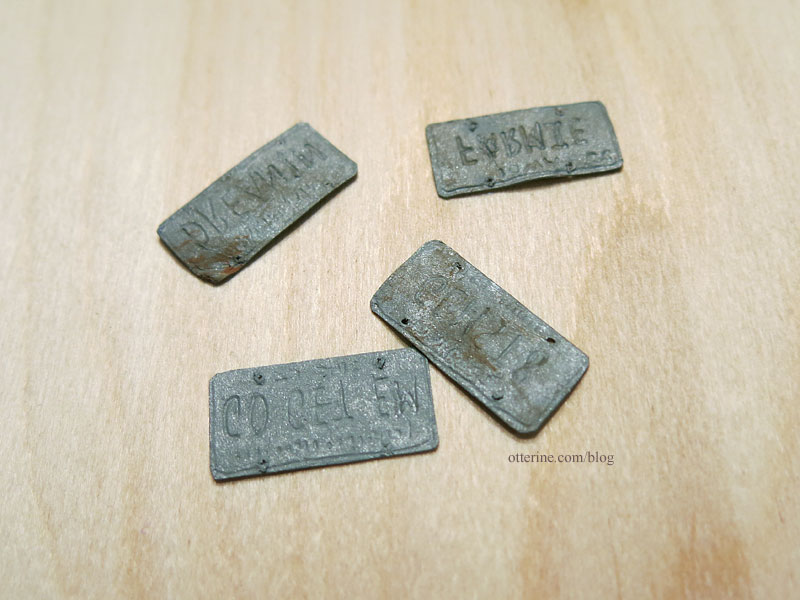
The GO GET EM plate is for the Datsun, so right now it is cleaner than the others. I will age it when I get to that part with the car. I also need to make another for a match set. :D
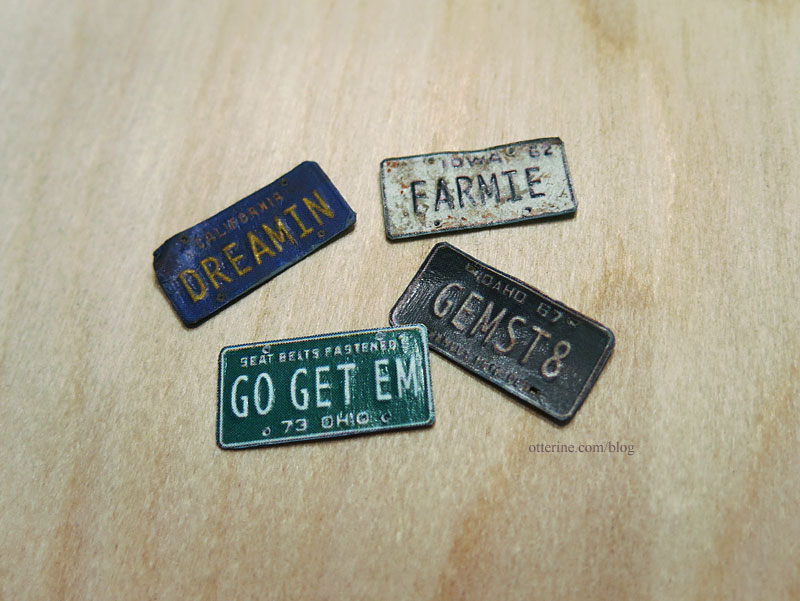
I’ve made a listing in my etsy shop for mini custom made license plates. There are some limitations for reproducing the plates in miniature. The image generator I use doesn’t have all years and some images work better than others, but with a good image I can try my best. The old tattered ones tend to look the most realistic as well. :D
Categories: Model Cars, Vehicles
April 4, 2015 | 0 commentsDatsun 240ZG – part 2 – color
Continuing work on the 1:12 scale Datsun 240ZG by Tamiya. Once the front brakes are assembled, the parts are supposed to spin. Success so far! I’m mixing the different colors of metallic silver on the fly to achieve various types of metal. I think this adds realism even if these aren’t the truest colors for the parts. Obviously, these have not been dirtied up yet.
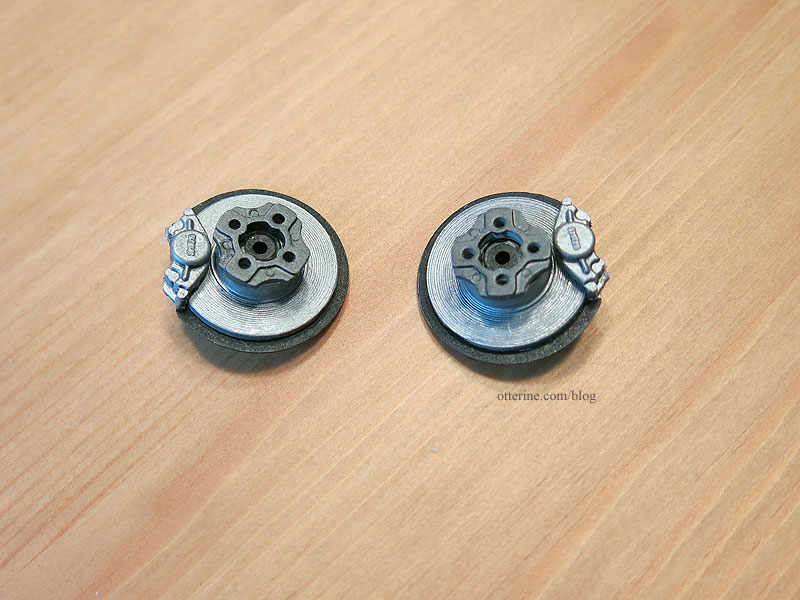
I spray painted the underside, wheel wells and engine compartment flat black. I then did a quick spray of flat grey in the engine compartment. I didn’t worry too much about overspray for the grey since this will be a grungy car when I’m done and grey will be part of the dirt process.
The engine compartment is supposed to be the same color as the exterior, however, so I needed to do some masking before doing that part. I used a bag to cover the majority of the molded chassis. I then taped off the wheel wells and front portions of the underside. I always wear a latex glove and hold pieces in my hand when spray painting for better control.
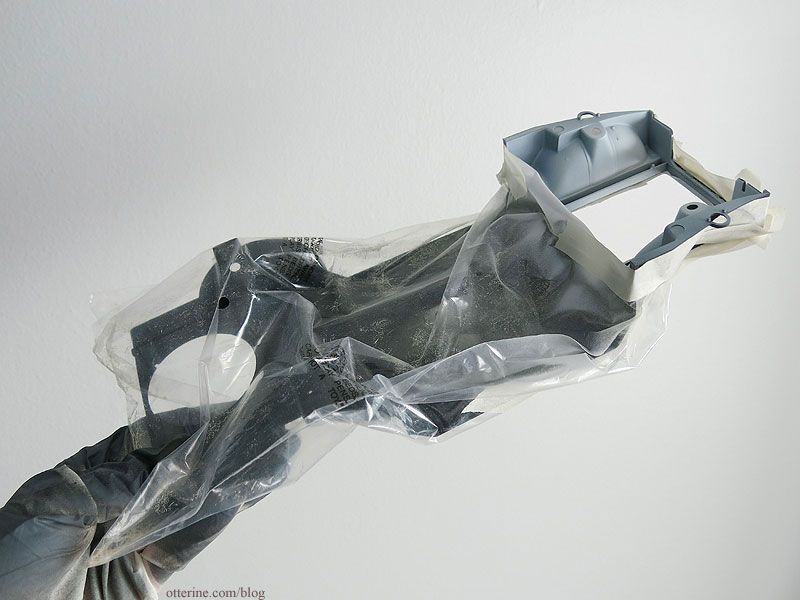
I sprayed a quick layer of flat white, not worrying too much about getting into the recesses. The black, then grey, then white layers will create some depth under the final paint color before I even get to the aging process.
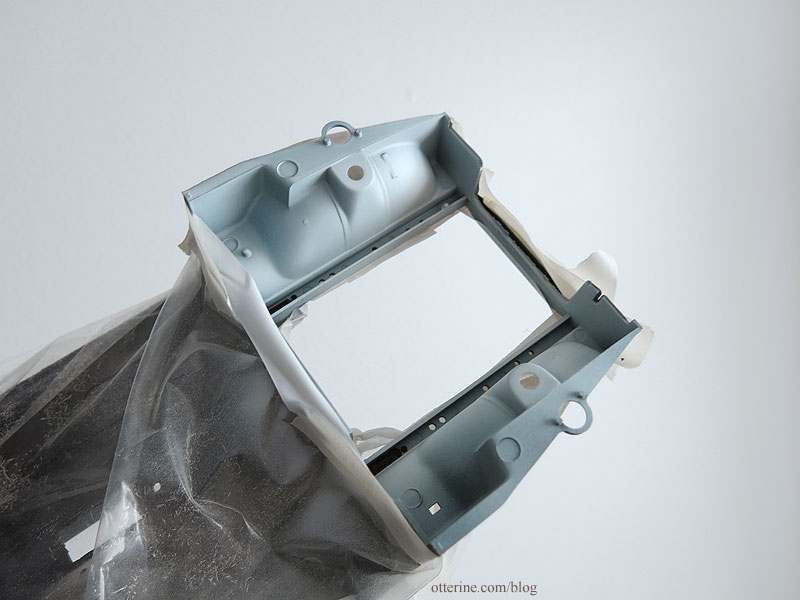
Next up was the final coat of Testors Fiery Orange. Wow! This is one awesome color! :D
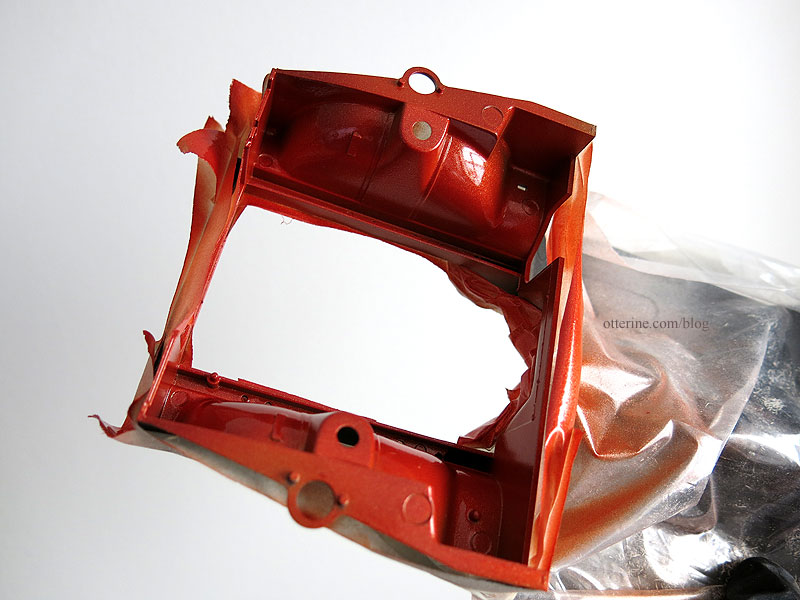
The engine compartment is now body color and the whole piece is ready for its place in the assembly.
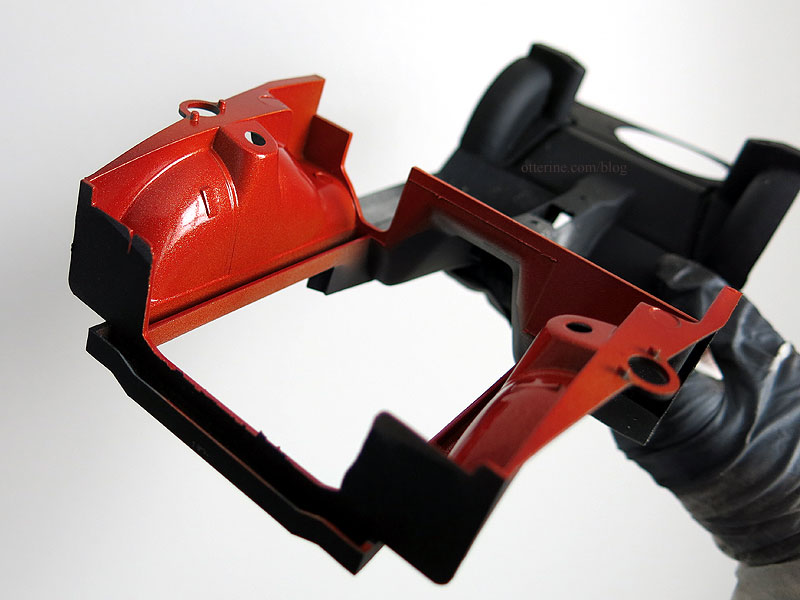
The nice thing about doing the engine compartment before painting the body is that I can try things out here. Even though this will be a barn find car, it’s better to experiment with the lesser seen places first. :]
Categories: Milo Valley Farm, Model Cars, Vehicles
April 2, 2015 | 0 commentsDatsun 240ZG – part 1
I’m going to start this build with a disclaimer: I am an artist, not a modeler. This is a very specific car, so be forewarned that I plan to take several liberties with it strictly for taste. I’ve scoured the internet and saved a bunch of photos of the real deal cars as well as some of the fantastic models done by top-notch modelers. There are some fantastic stock and modified builds out there, and I admire the dedication and thought that went into those projects. I will link to some these during my build. But, my end goal here is to create a barn find. How well-preserved or how dilapidated it ends up, who knows. One thing I do know…it won’t look much like the box art.
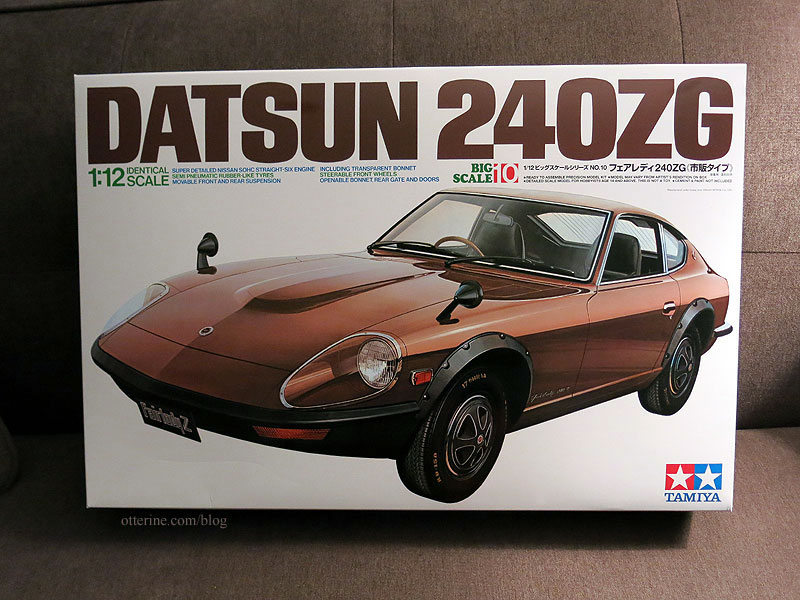
There are 14 sprues of parts with a smattering of other pieces. So far, I’m really impressed with this kit. I’ve not built a car this large, so the details are wonderful. There are also pre-colored light covers and rubberized parts beyond just the tires. I plan to build a complete model, but I’m not going to be a stickler for every last detail. I will be adding a few elements not included in the kit, though. A lot of this car will end up dirty, too, so some details will be lost in age and grime anyway. I will pick my battles. :D
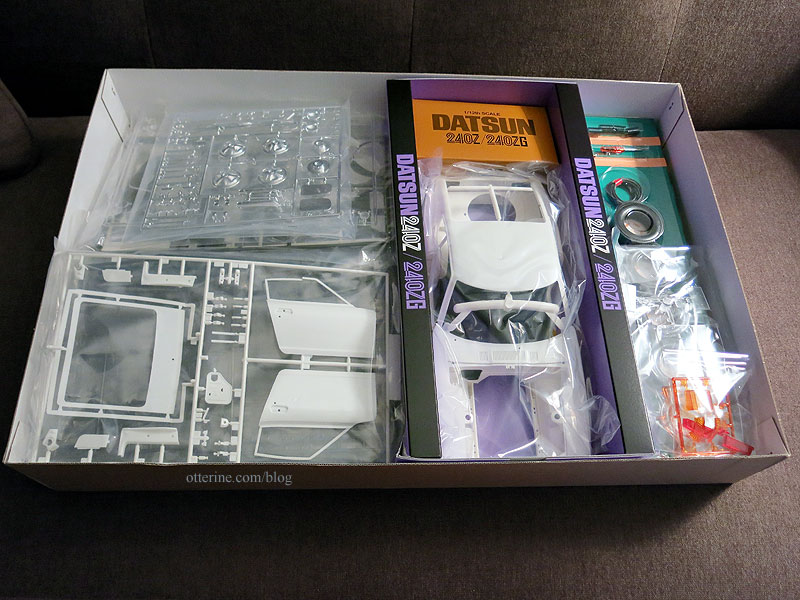
There are 14 pages of detailed instructions in building the model, one of which is the main body color chart.
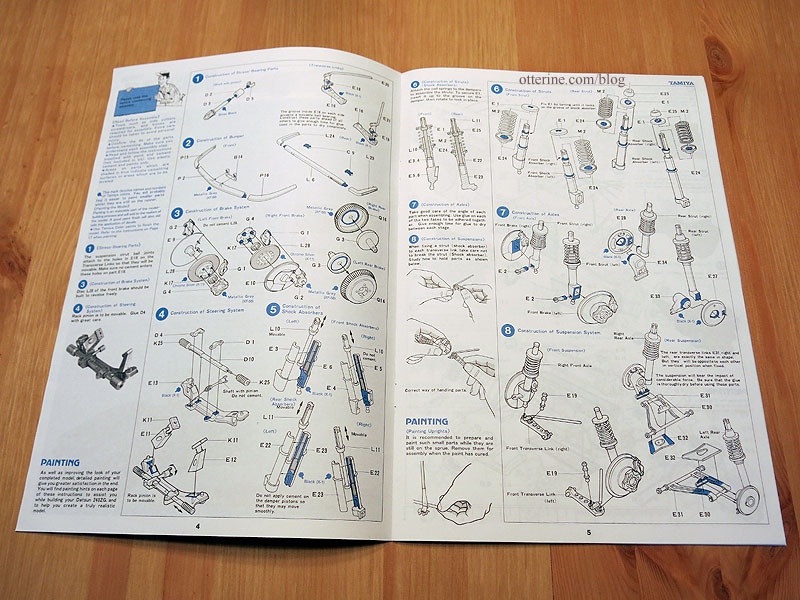
One of the first liberties I am taking is the body color. I bought Testors Fiery Orange. It’s a beautiful red orange metallic. It’s so lovely that I came so close to making this a well-preserved barn find. I’m going to have to spray *something* new in this beautiful color to satisfy that itch. I’m a fan of this color, just so you know.
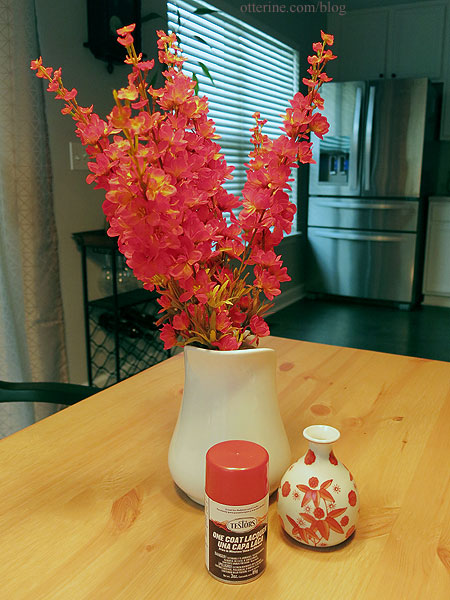
If I were making a showroom new model, I would take more care to study all of the parts before priming. As it is, I primed whole sprues in a color close to their molded color. I like to work with primed plastic because I feel I can work more fluidly with colors and textures on a primed surface.
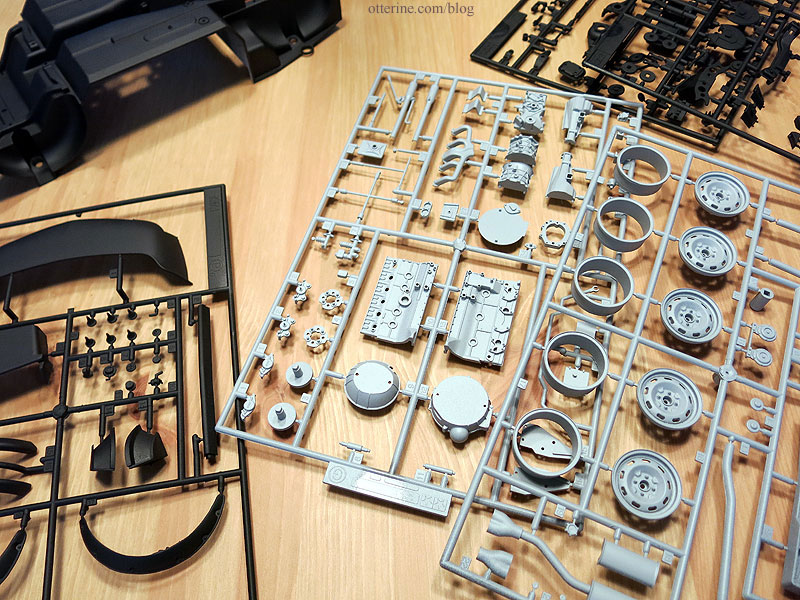
I bought a bunch of Testors bottled paints (plus one Model Masters) and have a few brushes on hand to start. No reason for Testors other than I like their paints and have some already in my stash. I will also be using craft paint acrylics.
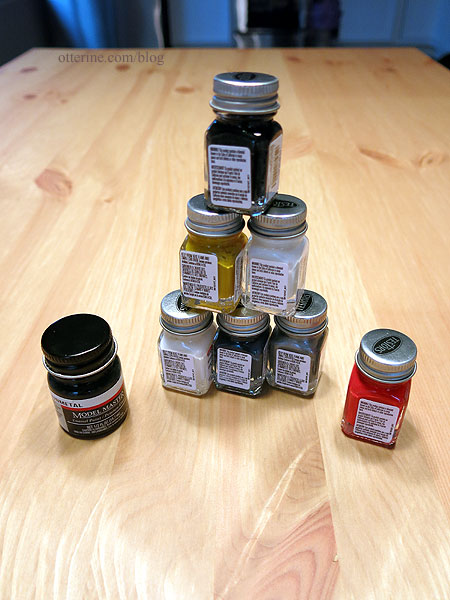
I won’t be detailing every step of the build here on the blog but will post updates along the way. I’ll also make a recap post with links to the various steps as I get further along. So, that’s where I am now…primed sprues, instructions opened to step 1, sample photos ready.
Categories: Milo Valley Farm, Model Cars, Vehicles
March 22, 2015 | 0 commentsMilo Valley Farm – cars and scale
Whenever a contest build comes up, I often end up with two good ideas that are completely different and I have to choose one direction or another. Such is the case with the HBS Creatin’ Contest this year. I bought the kit for Denise’s City Cottage and have been working behind the scenes on my contest entry following one of my two ideas.
But, the other idea will now see the light of day thanks to HBS! They’ve kindly offered to send me a kit so I can blog publicly about my build. Now, this public build using the free kit won’t be entered into the contest to keep it fair to those who have purchased the kit to enter. But, my secret build will still be entered since it has already been started from the kit I purchased at the beginning of the year.
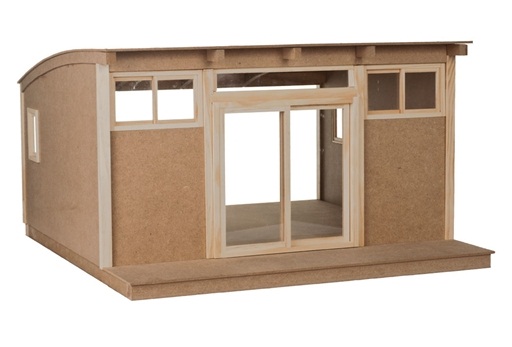
So, what’s the idea? A barn find! Here are two great examples of the look I’m going for: a 1961 Jaguar E-type and a 1952 Barn Find Cunningham C-3 Coupe #5209. Barn finds can be quite sad looking at first sight but turn into cash cows and museum gems.
I’ve named this build Milo Valley Farm after my current hamster friend.
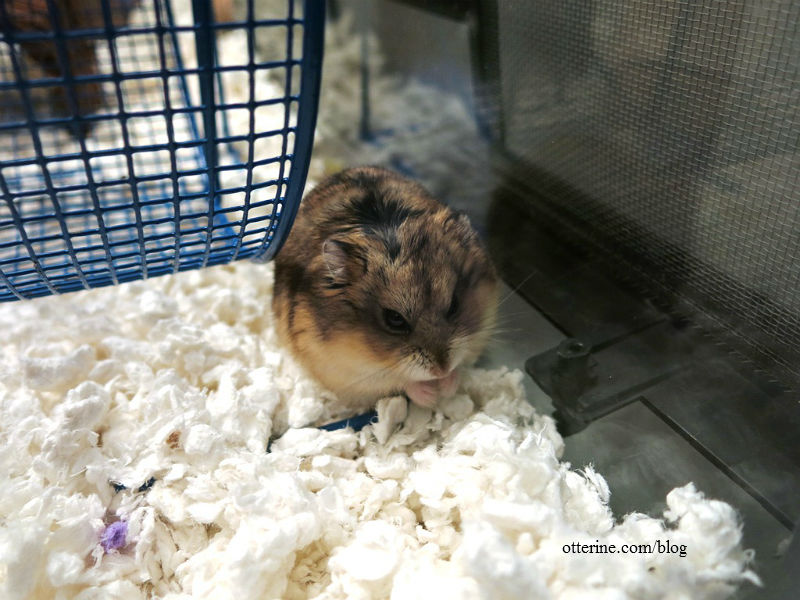
I found a great deal on a 1:16 scale Karmann Ghia, but it was in the UK. Pepper was kind enough to help me out, and the kit arrived in quick fashion.
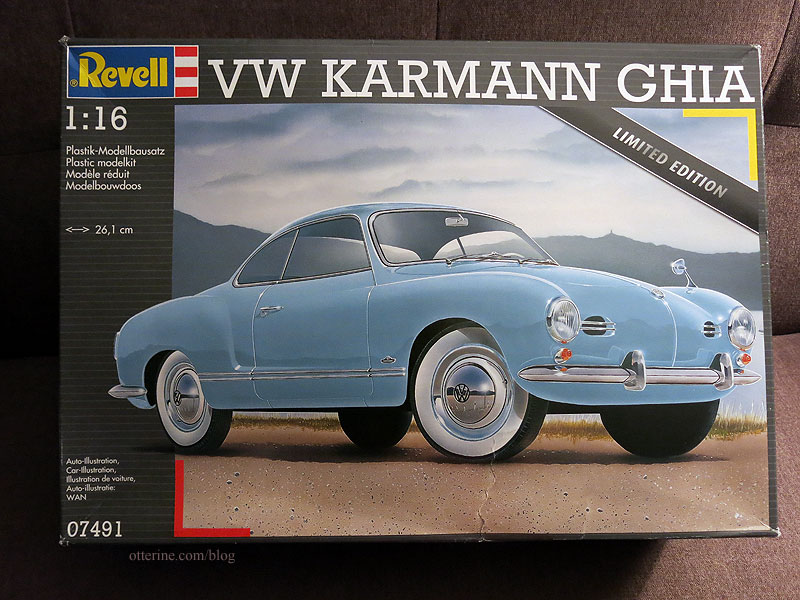
As big as the box is, the car itself is just a bit too small for the building. It leaves too much space to fill. I don’t want the barn to look like a flea market…the car should take center stage for the interior.

In truth, a 1:12 scale car works best inside a 1:12 scale garage. Makes sense, no? To that end, I chose a Datsun 240ZG. This is a 1:12 scale kit by Tamiya, and they can be pricey. I wouldn’t say the kit was cheap, but VRC Hobbies had a non-scalping price for it.

The 1:12 Datsun will be roughly 14.25″ long according to the info I’ve been able to find online. The interior depth of the kit is roughly 15.25″, which is not a lot of wiggle room. It looks fine here because the front end isn’t attached to the model yet.
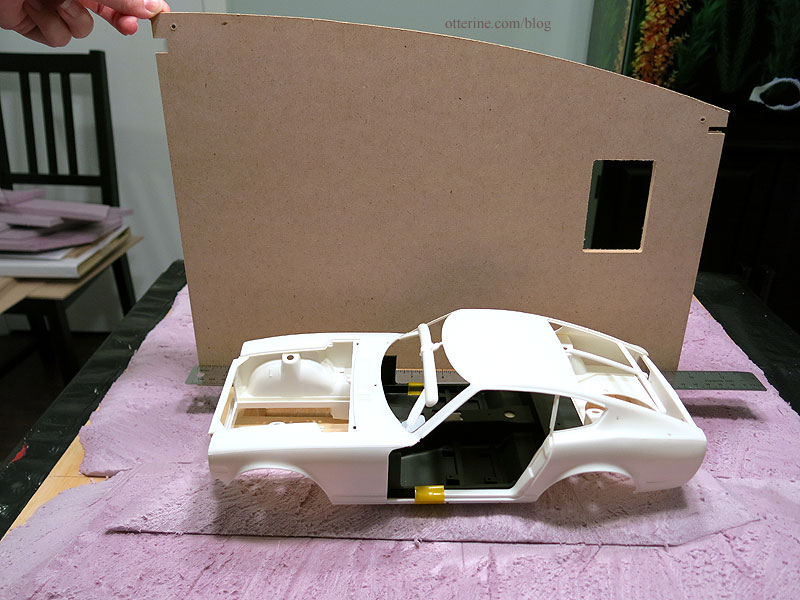
The 1:16 Karmann Ghia is better for depth with the side wall, though not necessarily for height.
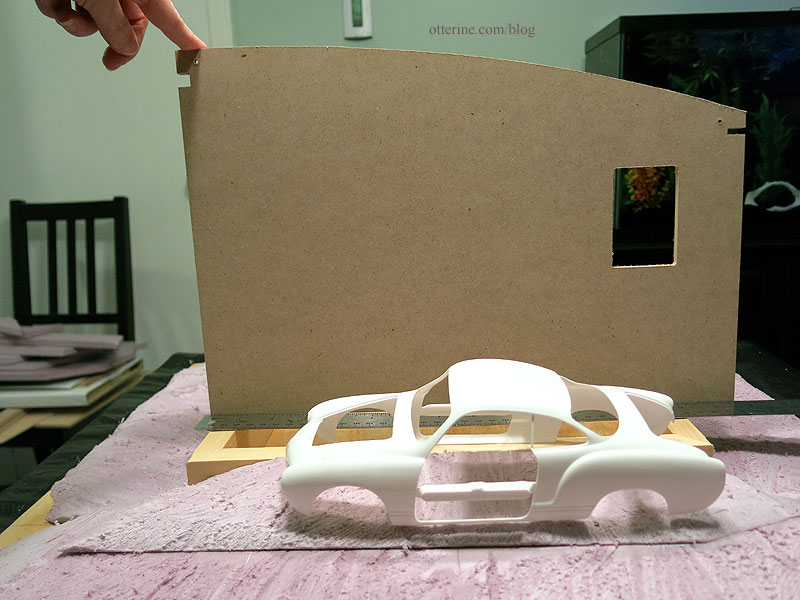
Once you add 1:12 scale items next to it, it fails the test completely. I don’t want to make everything else in 1:16 scale when I can just add a little depth to the kit.
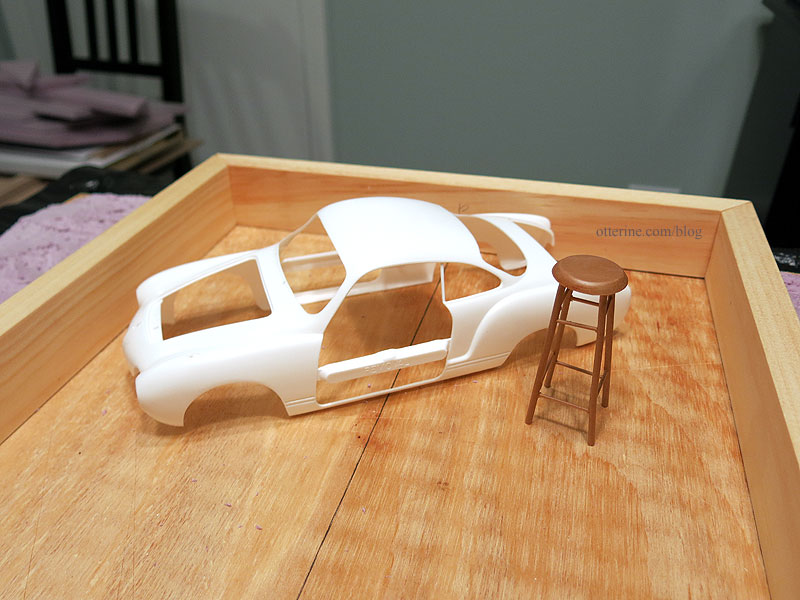
Better.
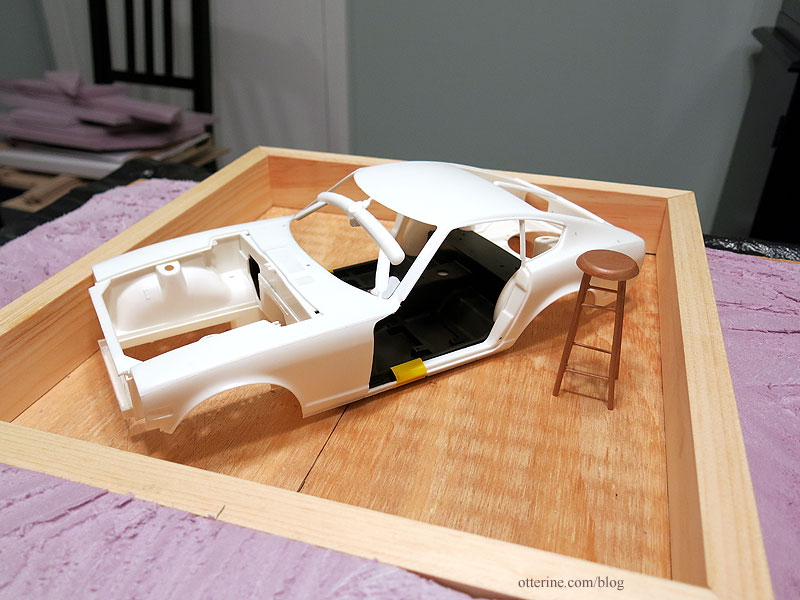
Looks like the 1:14 scale Audi TT would be a great happy medium, but it’s not a kit, too new to be a barn find and not something I want to wreck besides. As far as I know, there are no 1:14 scale model kits.
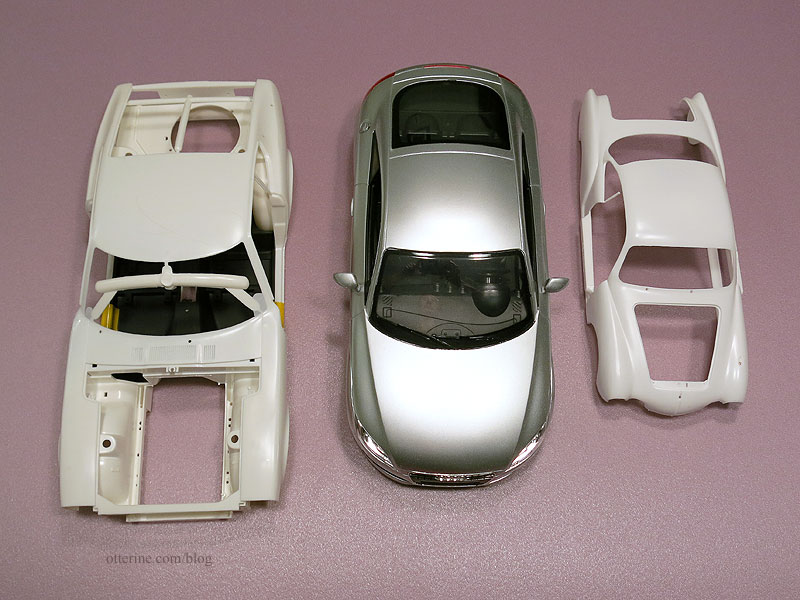
So, the Datsun wins! :D Friedrich approves.
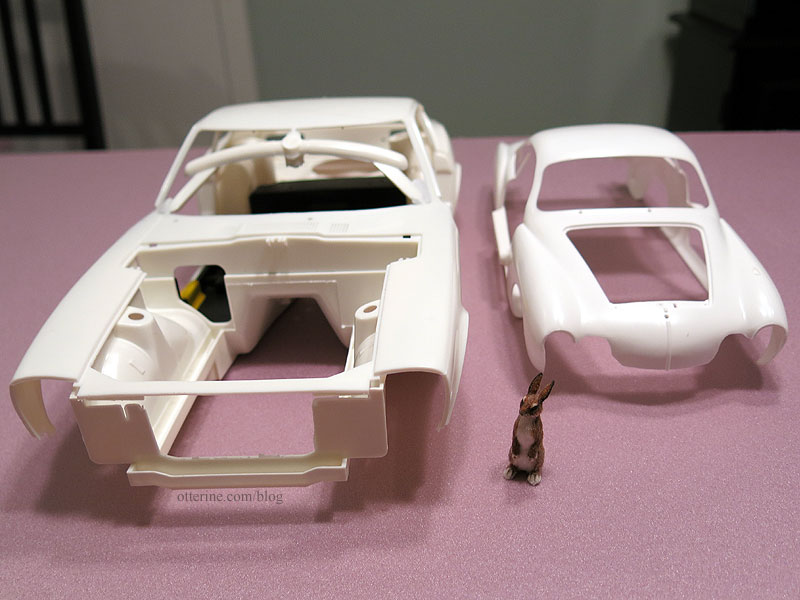
I also picked up a 1:12 scale Tamiya kit with various tools on eBay.

Is it wrong that I got all giggly about having an oxy-acetylene torch in miniature? :D

Categories: Milo Valley Farm, Model Cars, Vehicles
March 11, 2015 | 0 commentsMail call!
I ran across an old Rondel Wood Products Mail Wagon kit on eBay, and now it’s in my house. Why? Peer pressure, plain and simple. You all know who you are!
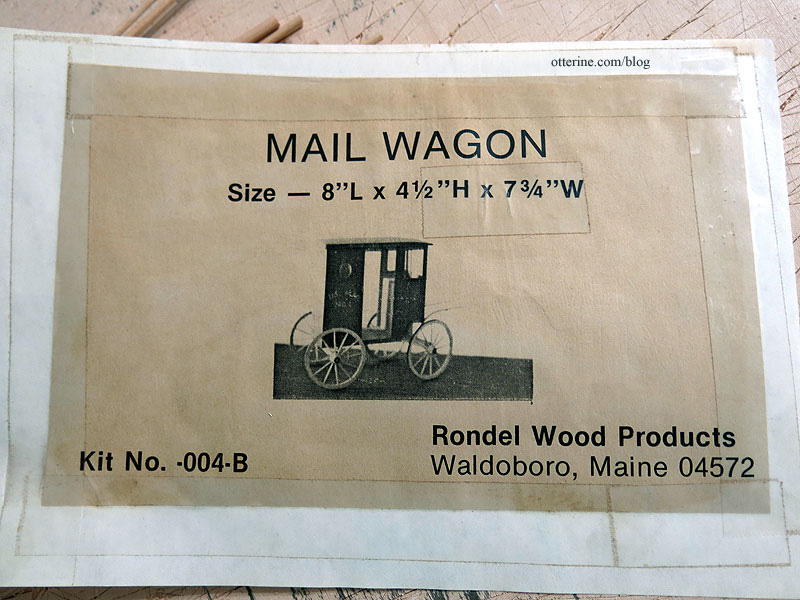
All kidding aside, it’s a simple little kit that makes one of these: a rural mail wagon.
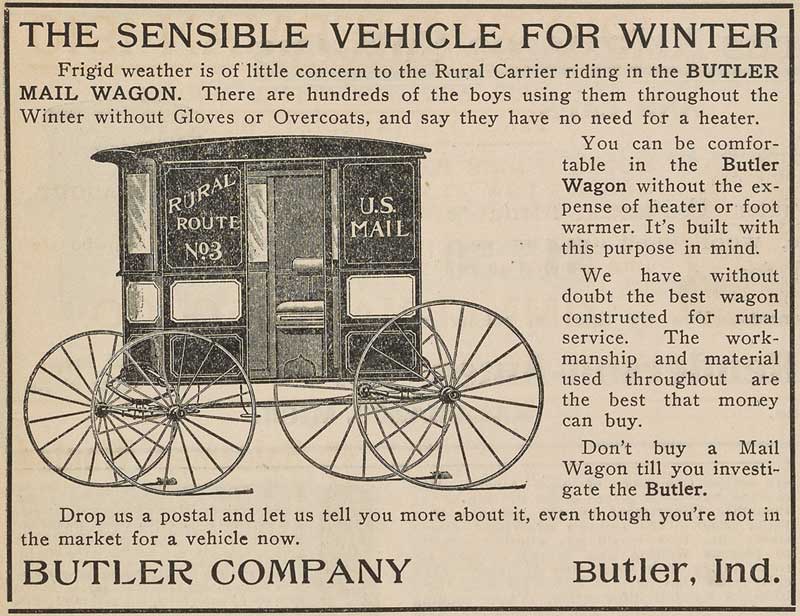
image from The Smithsonian Included in the kit is a large blueprint. Some pieces are pre-cut and some you do yourself. This kit was missing a piece, but that’s a relatively easy fix.
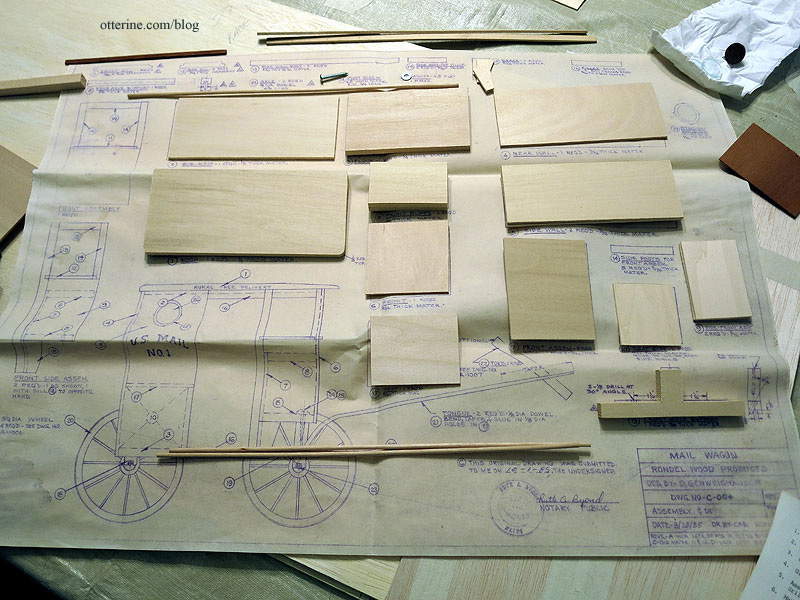
The plans and wheel drawing are even notarized. :D Not with original signatures, but still….
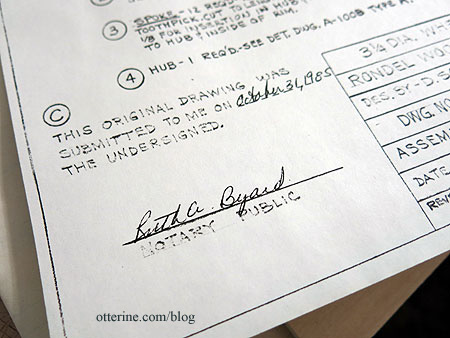
It comes with a jig for making the wagon wheels. Though these are made differently, I’ve made two wagons in the past and have some experience with the fiddly things.
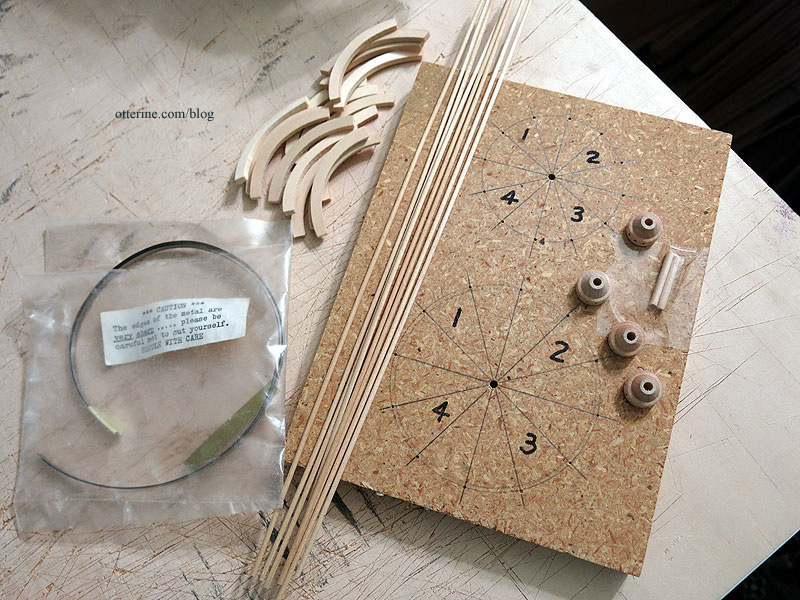
It also includes two tiny oval glass windows. :D
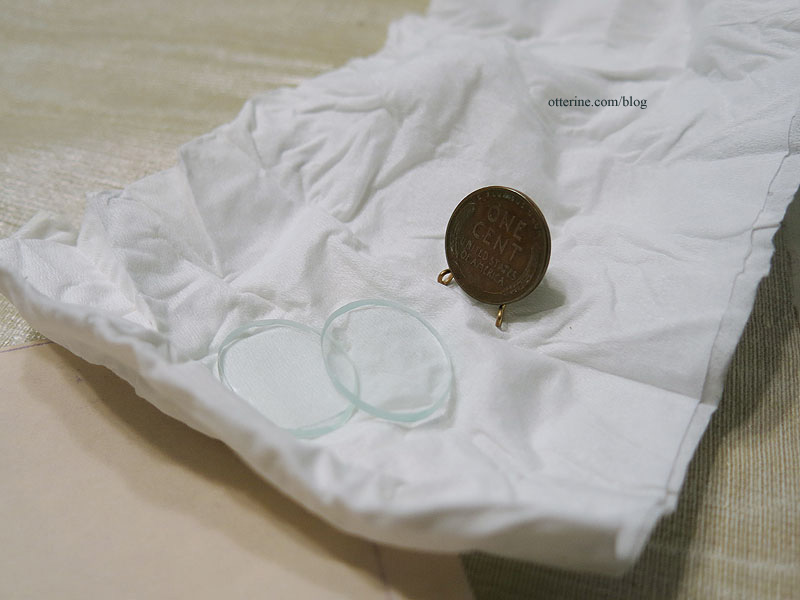
There are no materials for interior detailing included, but I will certainly add that.
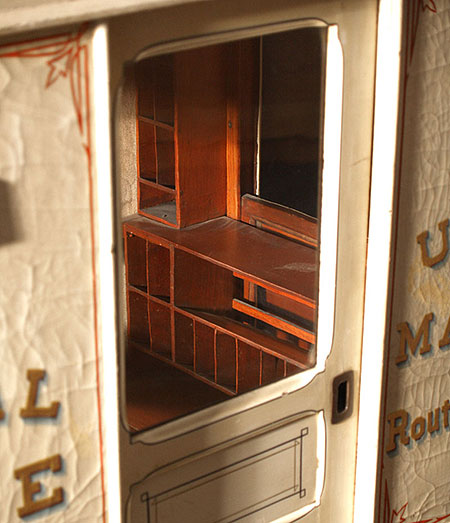
image from The Smithsonian These can be quite beautiful. :D In the kit, you’re to paint the lettering by hand. Riiiiiiiiight. I see Woodland Scenics rub-on letters in my future. :D
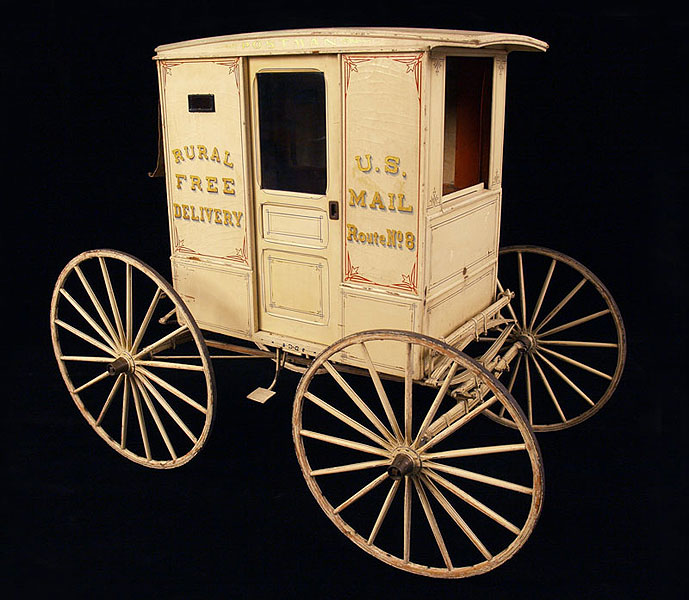
image from The Smithsonian Categories: Model Cars, Vehicles
April 21, 2014 | 0 commentsScirocco in mini
The most adorable tiny VW Bus was featured on Call of the Small a long time ago. I search eBay every once in awhile to see if I can find one for my own collection. Searching eBay is dangerous, because there are a lot of cute wee automobiles. This 1:87 scale Scirocco by BUB from nathan1002010 caught my eye.

In a 1:12 scale dollhouse, this would be slightly smaller than 1:6 scale, so a playscale car for a dollhouse. Look at that tiny VW emblem. :O

Race ya! :D

Categories: Model Cars, Vehicles
March 12, 2014 | 0 comments1950 Volkswagen Beetle
This beauty is a 1950 Volkswagen Beetle Saloon 1:12 scale model by Sun Star.
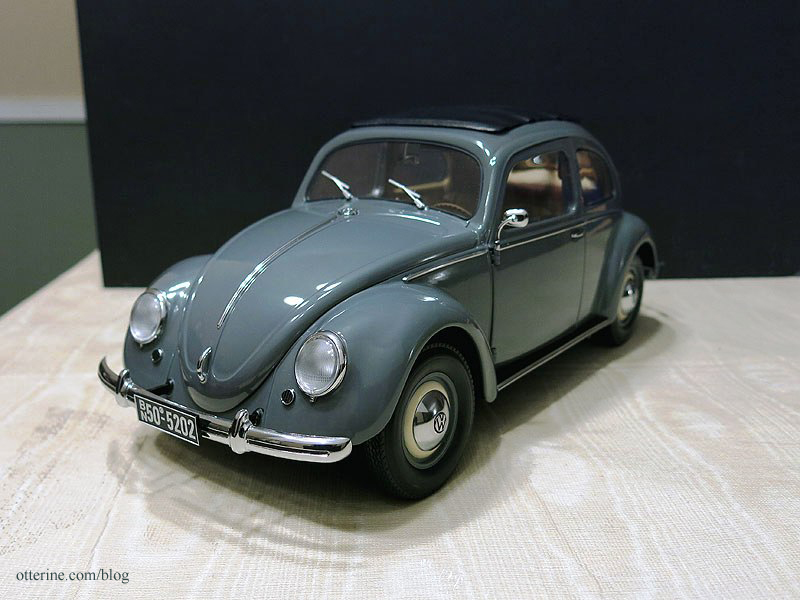
The 1:14 scale Audi TT remote control car I have is a nice reproduction, and I love that its headlights are functional as well. It photographs well, even though it doesn’t look as realistic in person.
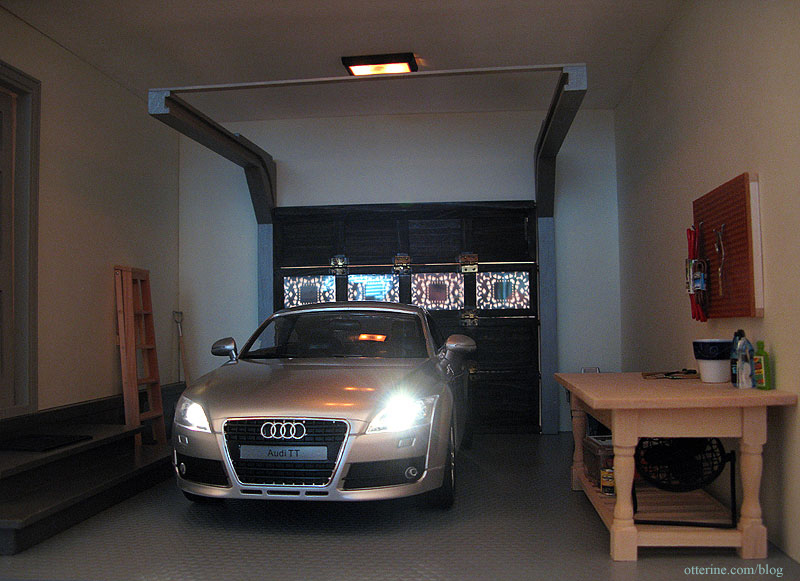
But, having a true 1:12 scale car for inside a 1:12 scale garage is the best for realism.
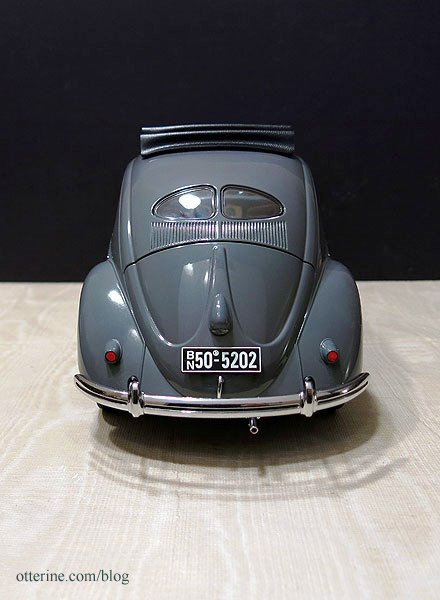
Look at the orange flag turn signal by the door. :D
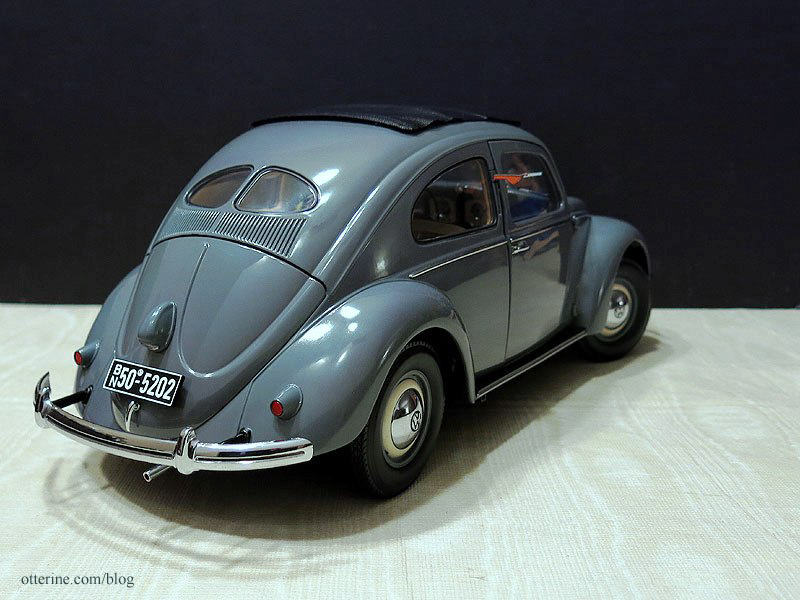
It has many moving parts and wonderful detail. There’s a tool with the model to help open the doors, hood and trunk. The front seats move forward, as does the back seat. The steering wheel controls the wheels. It is a bit rickety while rolling, but maybe that’s to scale, too! ;D I wasn’t too sure about the salmon pink carpet, but it’s growing on me.
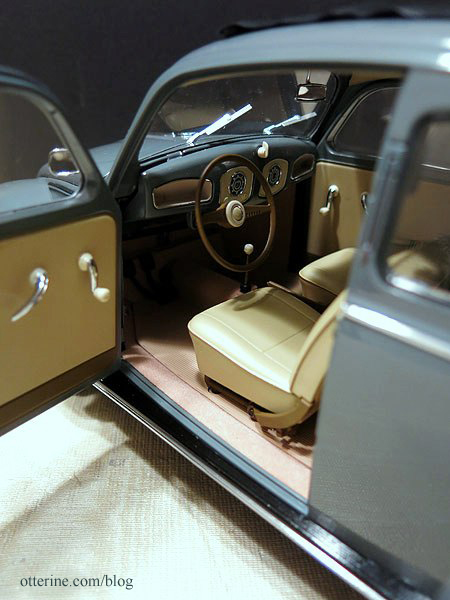
The cloth top retracts to show the interior.

Included with the model are a set of tools, a spare tire, a jack and lug wrench. Yes, the lug wrench works to remove the tires! :D I used a bit of mini hold wax on each of the tools because they were not fastened into the case and fell all over.

The case sits inside the spare tire and fits into a space under the hood. I placed the jack and lug wrench in there, too.

Engine in the back.

Some of the paint had a purple cast, and from what I’ve seen online, that seems to be a characteristic of this particular model. On mine, however, it was rather streaky.

I took some mild soap and water to it only to discover a weird pink residue on the tissue. It took some elbow grease to remove it all, but it’s now much better.

I mention this only in case someone buys one based on my blog post…so you aren’t surprised if this happens. The paint problem is in no way a bad reflection on the eBay seller, but more a problem from the manufacturer. The model I received was new in box. I’ve been very pleased with the seller’s communication. It turns out this is supposed to be a “pearl finish” for the car. That’s all and good, but it’s streaky and comes off. So, I’m glad I went ahead and scrubbed it off. I don’t plan to sell it, so I don’t care much about “resale value” without the pearl finish.
The Houseworks garage door kit is from miniatures.com. I’ve made a quick mockup to test the fit for the Beetle.

The fit is just right! :D

Categories: Model Cars, Vehicles
August 30, 2013 | 0 comments1:32 Scale Academy Sopwith Camel
My finished 1917 Sopwith Camel Replica.
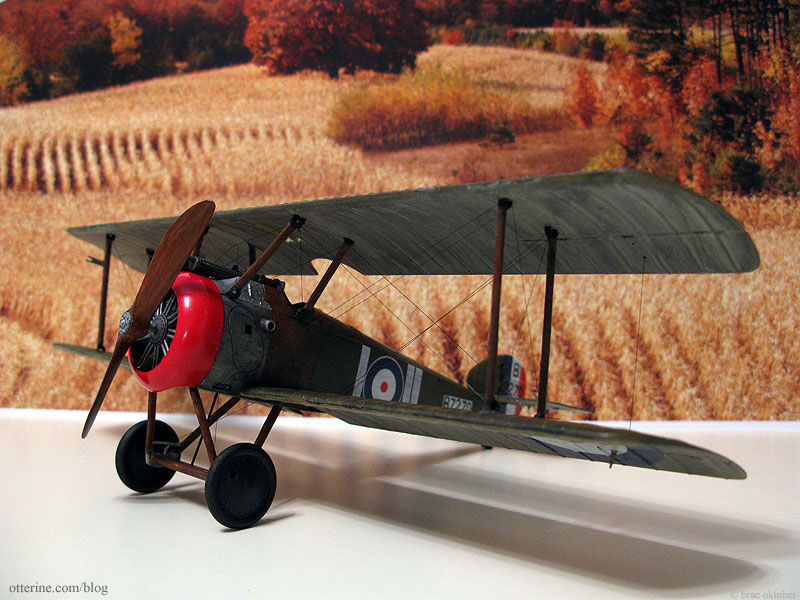
It has been a long time since I put together a plastic car model, and I have never done any sort of aircraft before let alone one with rigging. I learned a whole bunch of new vocabulary words during this part of the project, too! No, not new curse words…actual aeroplane terminology. :D
As with scale houses, there is a wealth of information out there on the internet. I found everything from novice builds to finely detailed expert builds. I opted for a 1:32 scale plane since a 1:12 scale replica would have overpowered the building itself as well as my condo. I think the one I chose looks appropriate for scale and enhances the project without taking over completely.
Considering the scope of my project and the fact that the aeroplane was meant to be one element in that larger project instead of a stand-alone piece, I used the base kit as is but put my painting and aging expertise to work! This is your basic plastic model and, as such, some detailing is lost and some is likely historically inaccurate. The kit was inexpensive, but I was able to eek out enough detail to suit my tastes without breaking the bank.
The wings of the original were fabric as were the tail and back portion of the body. After working with the Chrysnbon bathroom in the Heritage, I knew any little mark would show under spray paint. And, I had to fill in many injection marks on the pieces. So, while I was at it, I decided to try an experiment. I sanded the pieces with a linen weave pattern with a sanding stick. I sanded front to back and then perpendicular from side to side to create a very subtle matte cross-weave texture. Since flat paint still often has a sheen when sprayed over shiny plastic, I figured that even if the fabric texture didn’t show up clearly it would at least tone down the shine on the paint finish.
Here is the original shiny plastic.
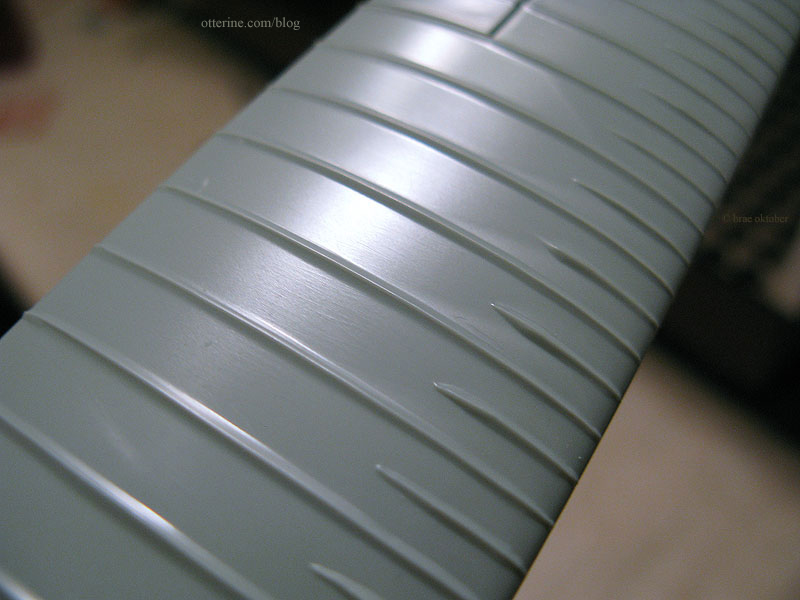
And, after the sanding…
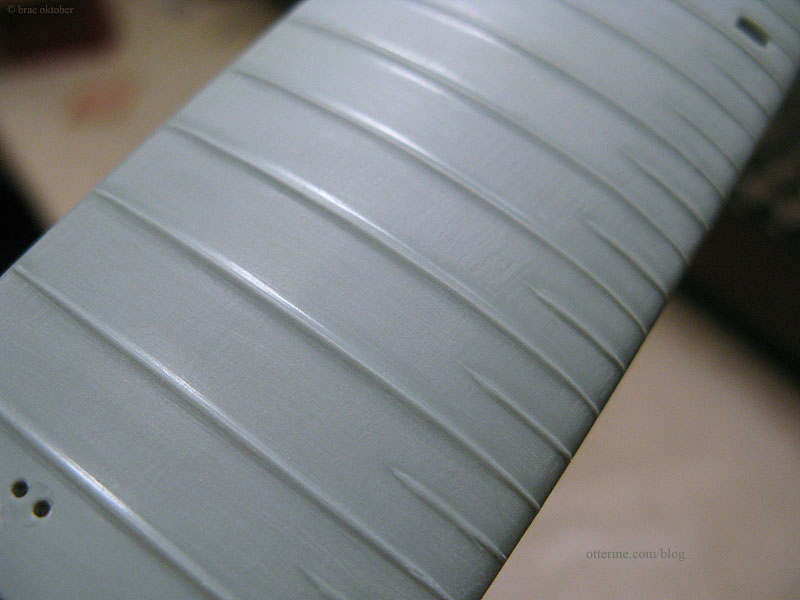
After the spray primer coat, the finish didn’t necessarily register as fabric, but it had a great matte, non-plastic finish. That was a success to me!
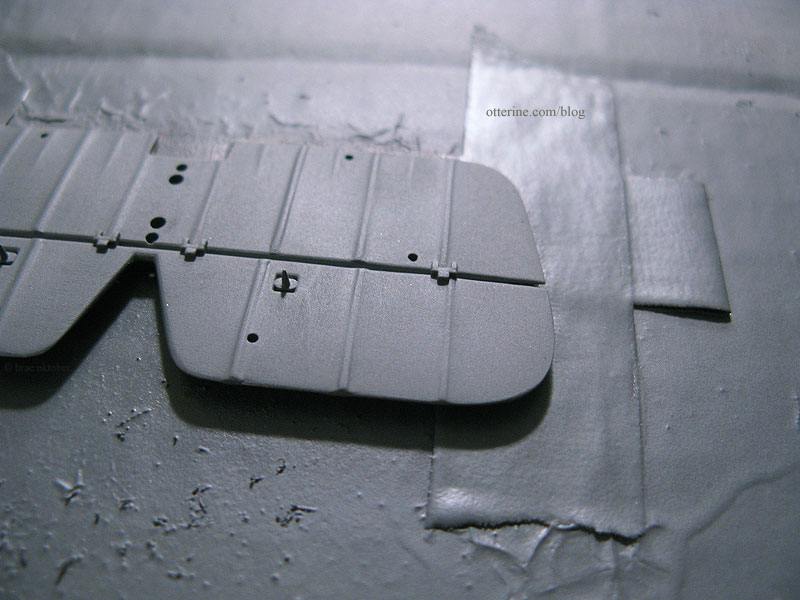
After the spray top coat of Testors Flat Light Aircraft Grey for the underside and Testors Flat Olive for the top side, the finish was just as I wanted. Well, I did have a few spray paint mishaps that required sanding and refinishing…but it’s an old replica, right? :D
The shiny red nose turned out so well, I couldn’t bring myself to age it or dirty it in any way.
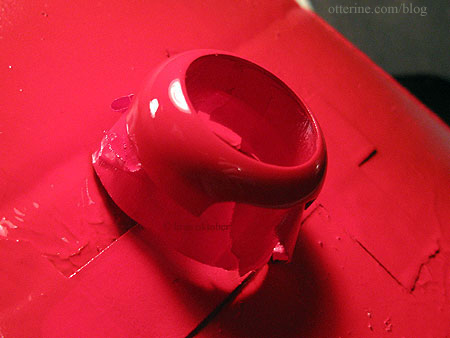
Not much of the engine shows, but I detailed what would be seen. It’s obviously a simplified version of the original, but I figured painting and making it grungy would be detailing enough. I brush painted the four engine parts with Testors Aluminum. Once that was dry I used black and brown acrylic washes to fill in the details, which it did wonderfully. It has the look of an oiled and working machine. :D
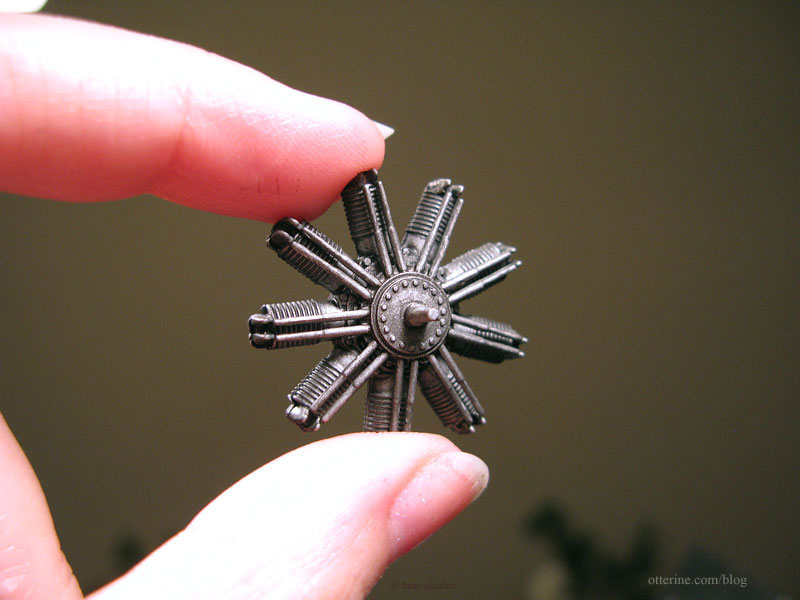
The “wood” portions were easier to mimic than I thought they would be. When I read that you were to first paint the base color and then paint on the wood grain, I thought, “Riiiiiiiiiiiight.” But, it works! I used a hand painted base coat of Testors Flat Light Tan followed by Testors Flat Military Brown, also hand painted and then wiped away with a paper towel. Maybe it’s not fine wood grain, but it is remarkably convincing.
There are some fantastic scale cockpit modifications people have done to accurately reflect the original planes, but I ended up using the original kit piece as is. I did the same wood grain finish on the interior walls, floor and dash based on the various models I had seen other modelers build. On the interior, I used black and brown acrylic washes to tone down the shiny new finishes. The instruments were first painted with a toothpick to fill in the black background. I then used a sewing pin to paint the instrument details using Liquitex Iridescent Bronze acrylic paint.
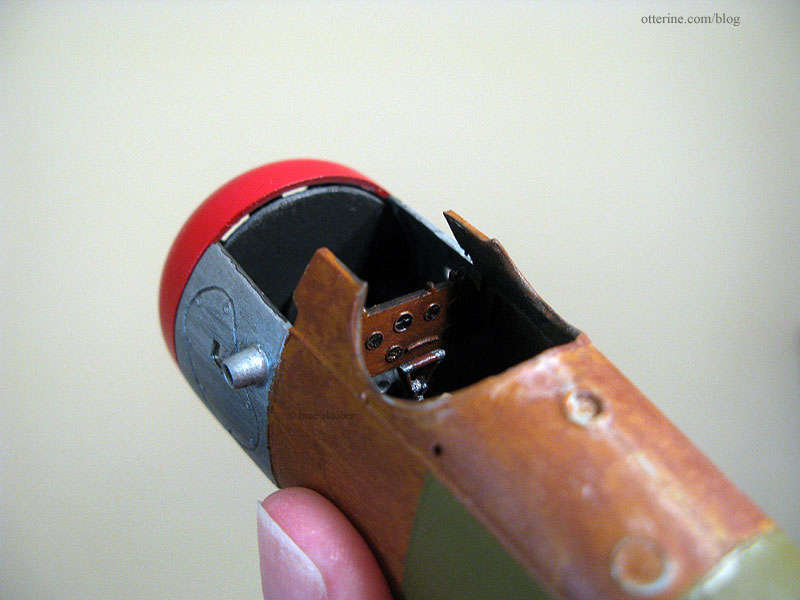
I had read that the guns were molded upside down in this kit, but with my shortened build timeline and the fact that I really didn’t want to start deconstructing parts, I used the guns as is. My model wouldn’t be the most accurate besides, and it would have been a lot of work for a minor payoff. :D
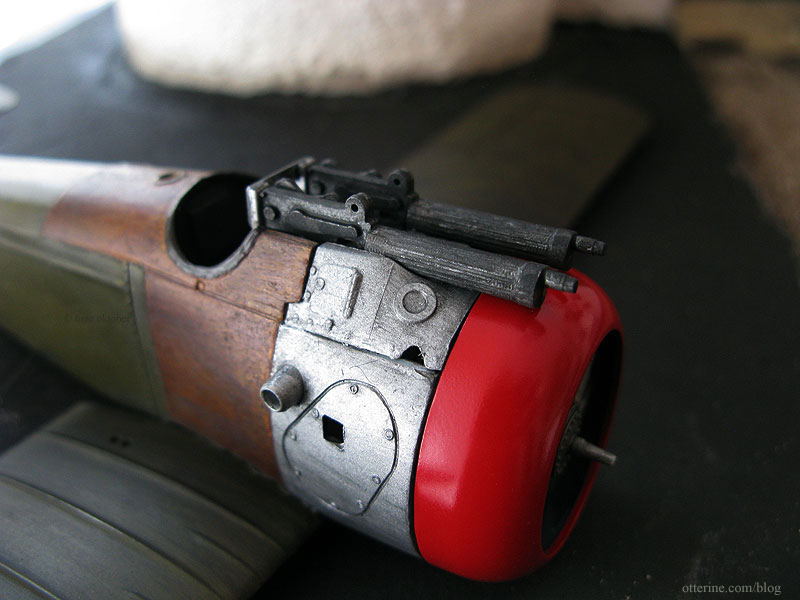
Show of hands…who knew what a turnbuckle was? :D I sure didn’t…but I found out about them in a hurry when researching biplane rigging. I found a tutorial on making these scale miniature approximations, but after seeing just how blasted tiny the materials were, I went with a more simplified approach.
I basically used the kit method, though I used black “transparent” thread instead of the kit supplied black fiber thread. I also waited until after the plane was assembled to add the lines. I didn’t see how you could add the lines during the body assembly, then keep them out of the way and clean during the painting process. This meant a bit more headache in the end, but it worked out well.
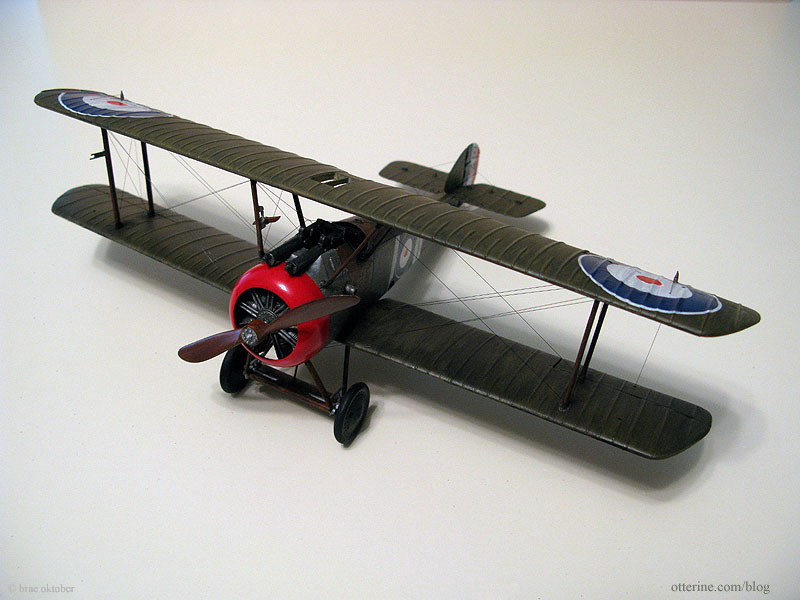
I mostly just used super glue gel to hold the wires in place in the pre-drilled kit holes. For the ones in the body, I cut small lengths of brass wire and slipped them into the holes with the wires. This plugged the hole and held the wire more securely. I dabbed black paint on them later to remove the obvious brass shine.
I started with the tail section, and in this photo you can see the brass pins before I painted them.
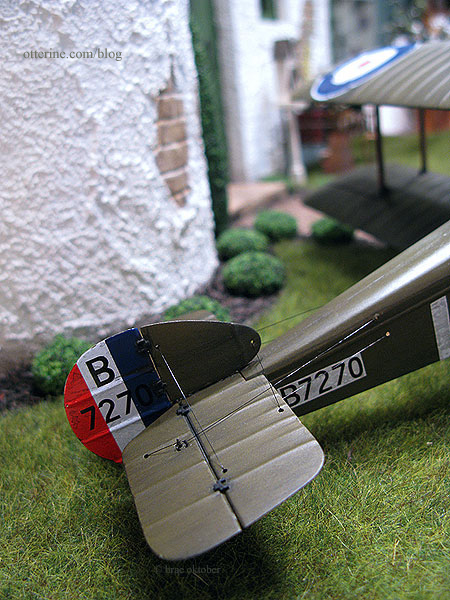
The decals were not the easiest things to deal with, and I admit to being out of practice using them. But, the end result was pretty good and this was meant to be a weathered replica, so any imperfections actually worked to my advantage.
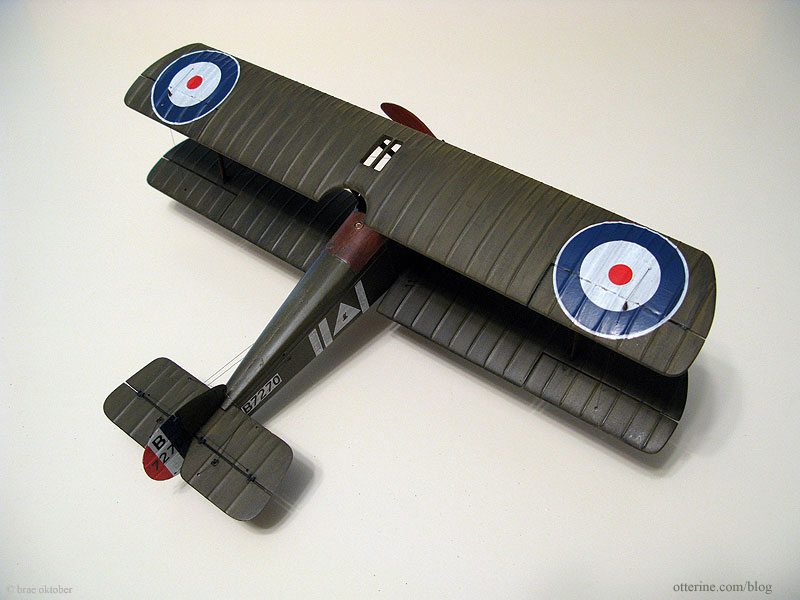
I followed most of the recommended placements and others I made up from the available decals…like the triangle with a logo in it shown below.
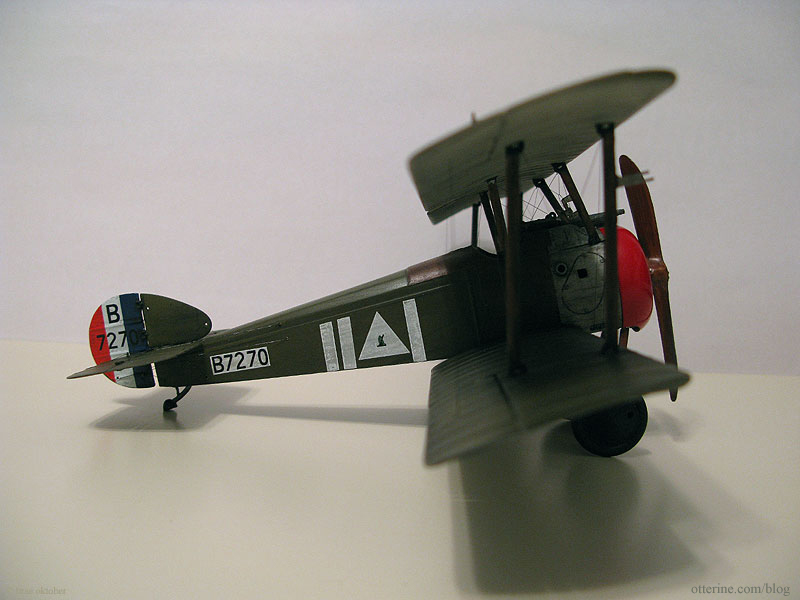
I made one substitution during the rigging process. There was supposed to be a straight wire from the bottom of the plane running perpendicular to the wheel assembly. I knew there would be no way to get the tension correct, so I used a cut off head pin. It doesn’t look like a substitution at first glance and it added stability to wheels besides.
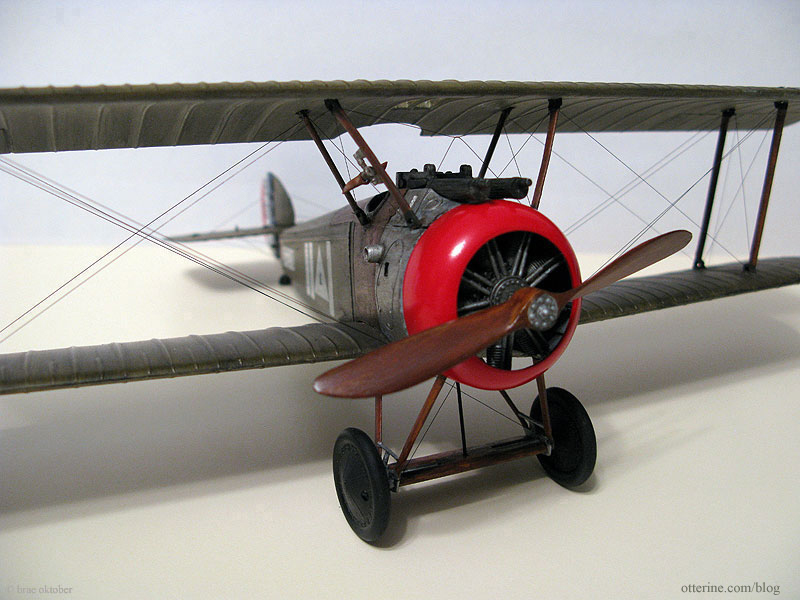
I was terribly out of practice with building plastic models and this was my maiden voyage with rigging, but I love the end result! Overall, I enjoyed the process of putting the model together even if I don’t foresee myself making a whole squadron of these. ;D
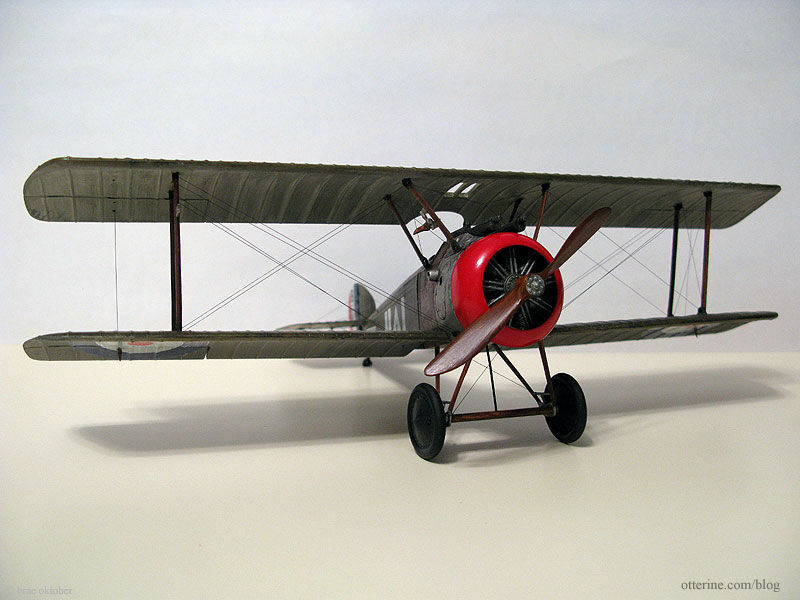
I found these fantastic Scene Master spotlights on amazon.com and instantly knew they would be perfect for lighting up the plane. They have a vintage industrial look about them that complements the plane and building. They are labeled multi-scale, and I think they work wonderfully in my scene. In the final layout, I used only one of the pair that were included in the package.
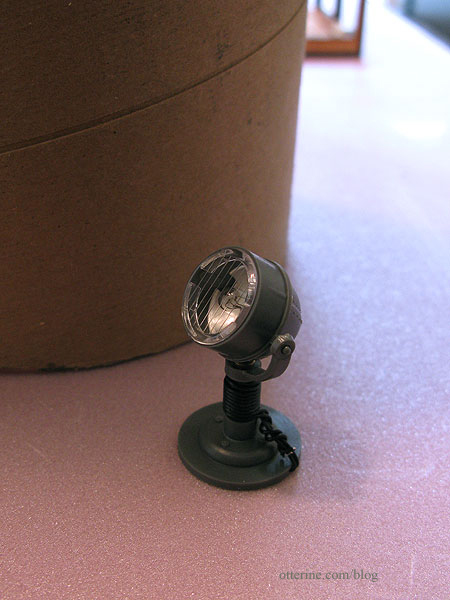
I aged it with brown and black acrylic to remove the plastic sheen.
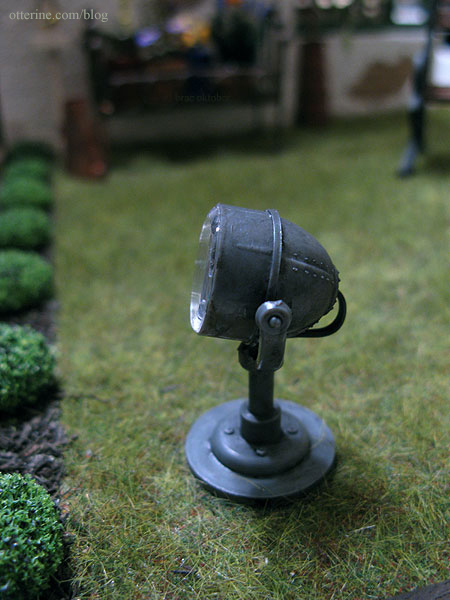
The sign verbiage is taken from the Wikipedia article on the Sopwith Camel. I printed it on paper, pasted it onto a primed wood scrap and staked it into the ground with some wire.
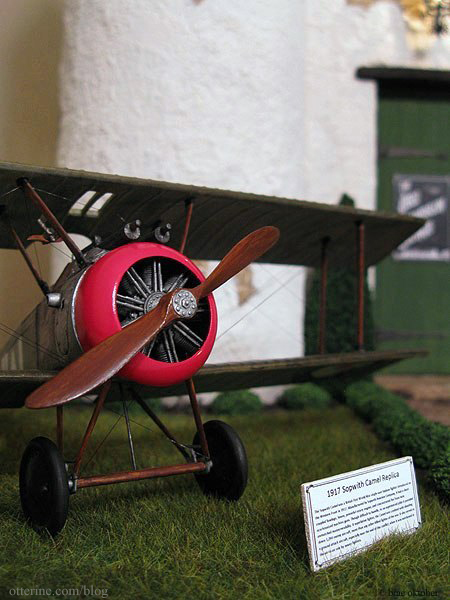
Be sure to check out these sources and inspirations:
– Excellent video of the same model kit with snappy music
– Beautiful kit model by Des DelatorreCategories: Model Cars, Vehicles, The Aero Squadron Lounge
September 1, 2012 | 0 commentsRoundy roundy wagon wheels
The Allwood covered wagon kit I transformed into a 1:12 scale farm wagon has an ingenious method for constructing the wagon wheels. They supply dowels you cut into spokes and the shaped inner hubs.
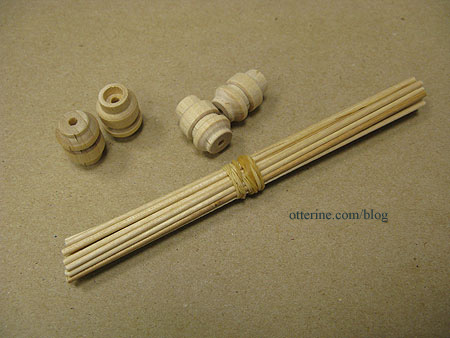
The wheels are made from two layers of diecut plywood glued together and sanded.
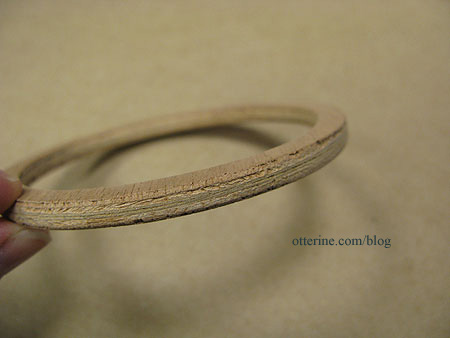
The ingenious part comes in the form of the jig used to line up the spokes. It is made from two layers of plywood lined up in the middle and glued together.
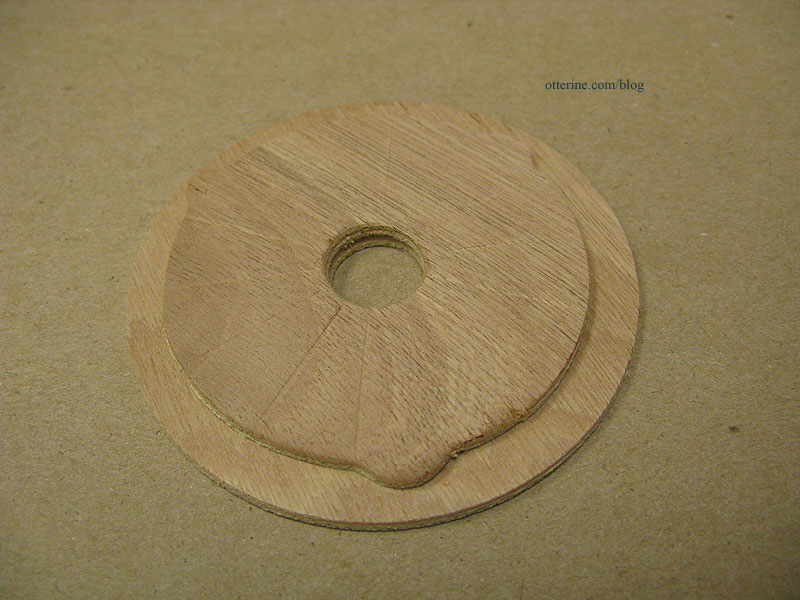
The wheel assembly fits snugly onto the jig and the hub is placed in the middle. The jig has grooves in it serving as a guide for the spokes.
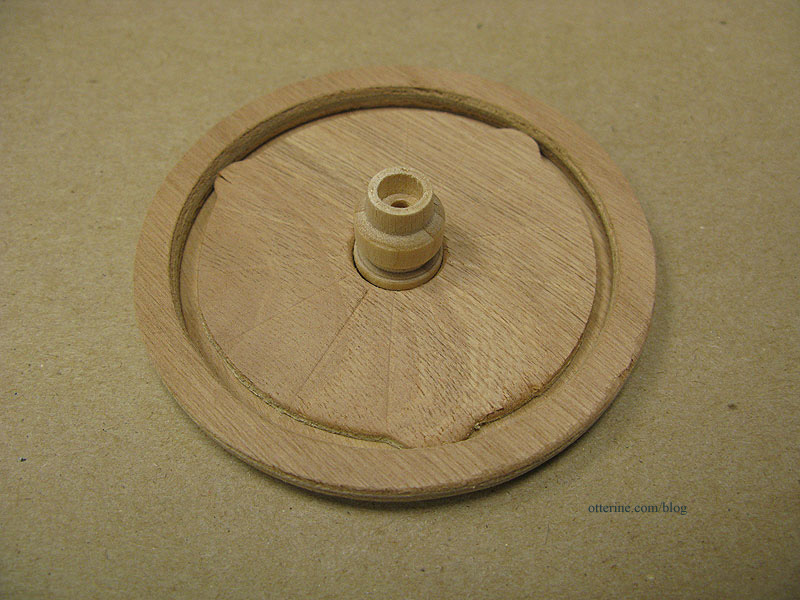
The instructions tell you to cut a whole bunch of dowel lengths to certain measurements, but I didn’t do it that way. Instead, I measured only the first one to the kit specified length and then measured the rest of the dowel lengths to fit. There was no way the standard measurements given with the kit instructions were going to work for all the spokes – some would be too long and others too short. That’s the nature of imprecise diecut parts.
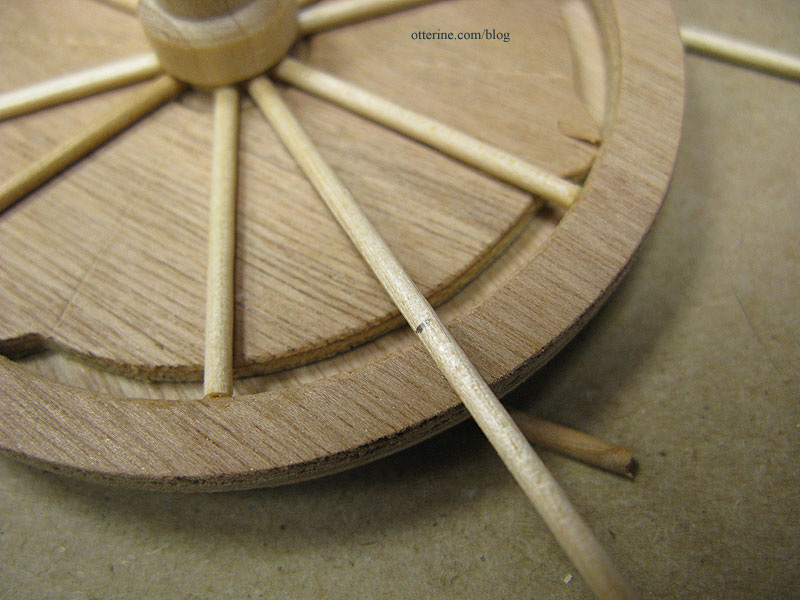
Once the glue has dried, the wagon wheel pops off from the jig. :D
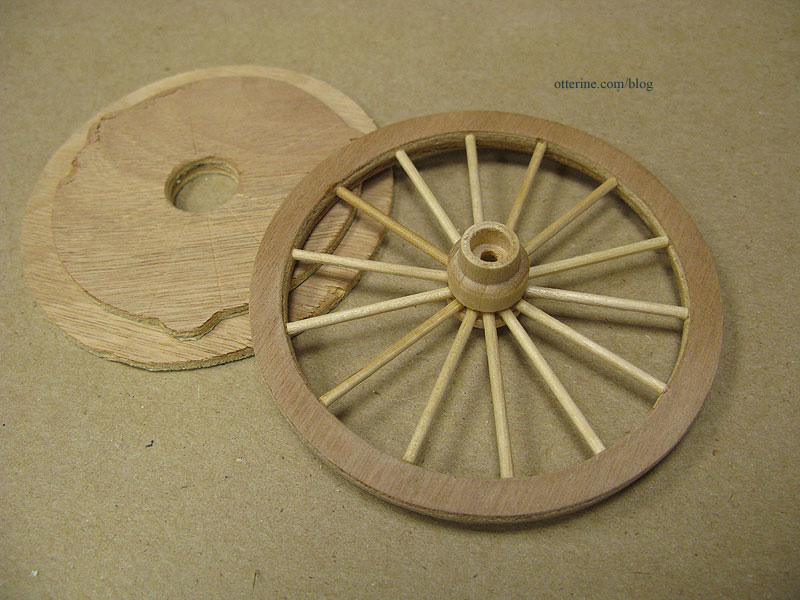
Categories: Baslow Ranch, Model Cars, Vehicles
January 25, 2012 | 0 comments
NOTE: All content on otterine.com is copyrighted and may not be reproduced in part or in whole. It takes a lot of time and effort to write and photograph for my blog. Please ask permission before reproducing any of my content. (More on copyright)
Categories:

RX-7 in half scale – lights, part 1
Continuing work on the RX-7 in half scale. Yeah, ever since I wired the Model T for LEDs, I’m going to have a hard time not wiring all my cars going forward.
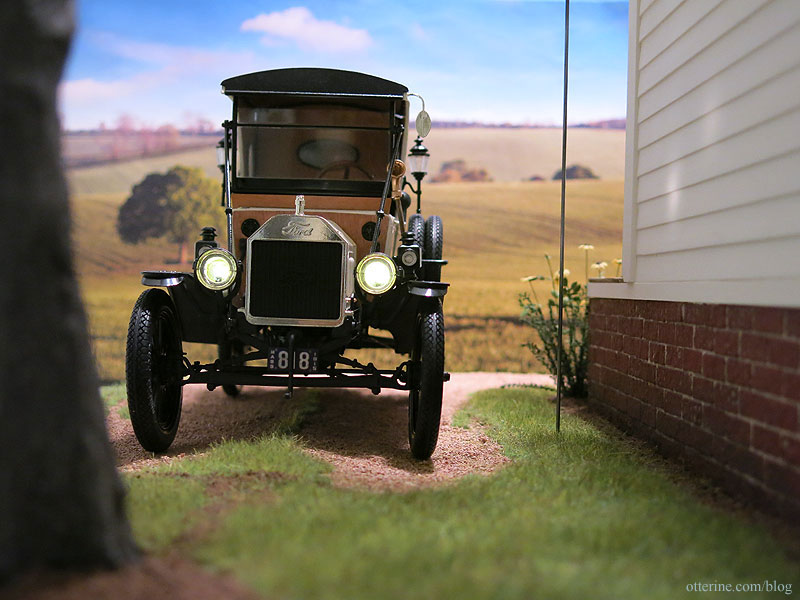
Since I’m looking to put in only headlights and taillights, I painted the back of the clear reflectors/side lights silver. The paint brings out the detailing and makes them appear brighter.
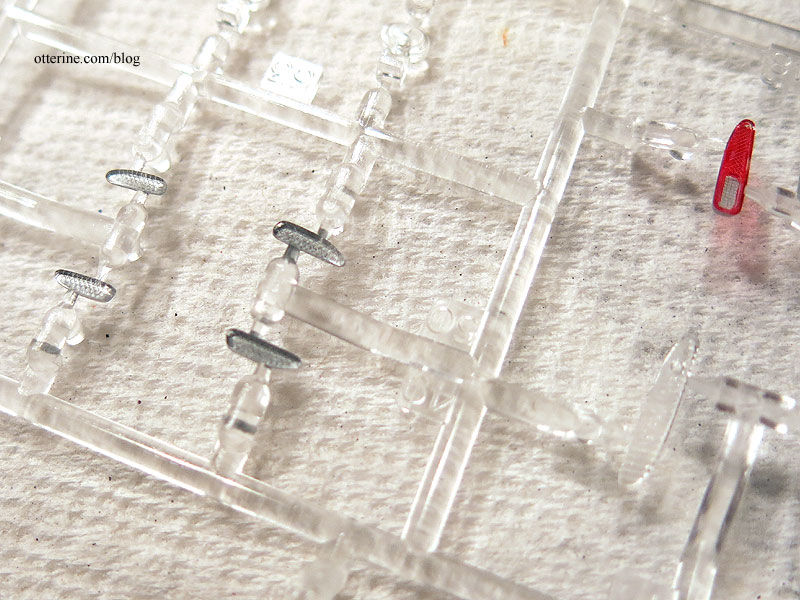
The rear lights are one continuous clear piece. I colored the red and orange portions with Sharpie markers. There is a slight third brake light in between, but there was no way I could have painted that without getting red all over the rest – it’s a tiny sliver too narrow for my markers. So, we’re not going to worry about it. Picking my battles. :D
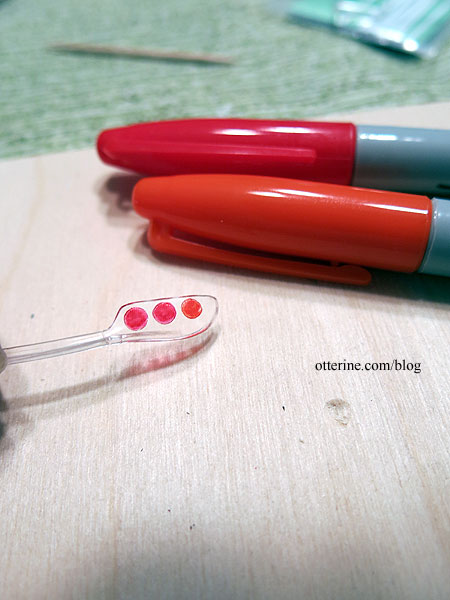
I masked the colored areas with Winsor & Newton Masking Fluid. This is a pricey fluid used for watercolor painting; it covers any space you want to remain white on a painting. You use an eraser to remove it from the paper after the paint has dried. I used a 50% off coupon at Michaels.
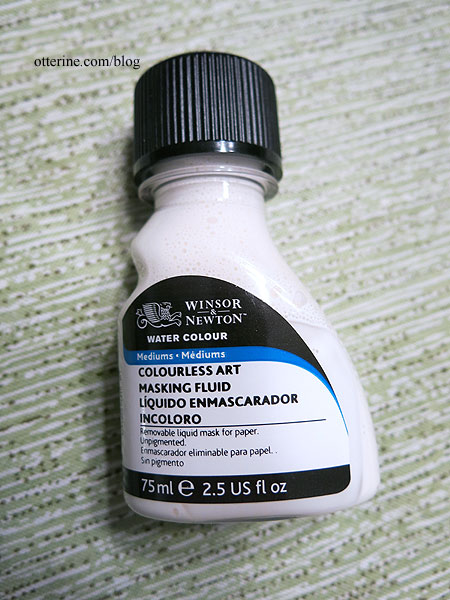
I thought it would work well to mask the lights since I didn’t think tape would really seal the area that well if I could even cut circles that small.
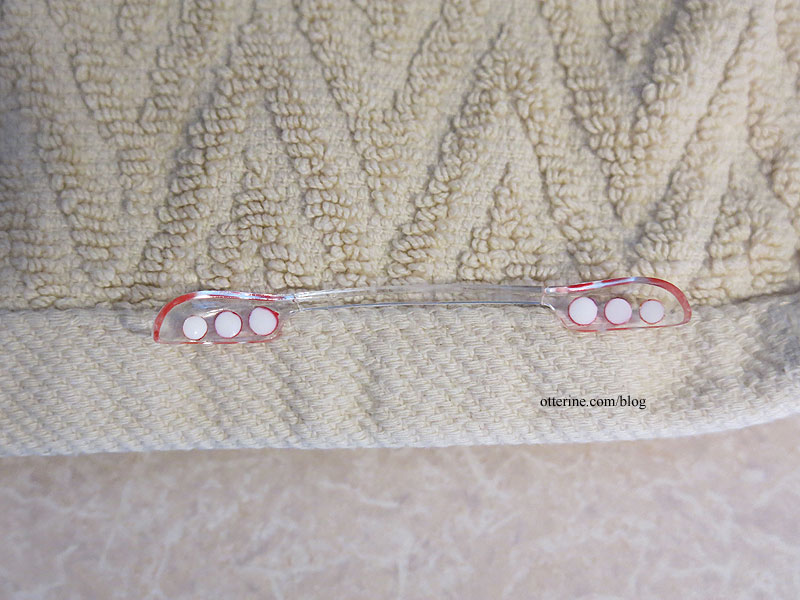
The nice thing about the liquid is if you don’t like the mask, you just let it dry and remove it to start over. It dries clear, which is good or bad, depending on how you look at it. Just make sure you are happy with the mask while it’s still white.
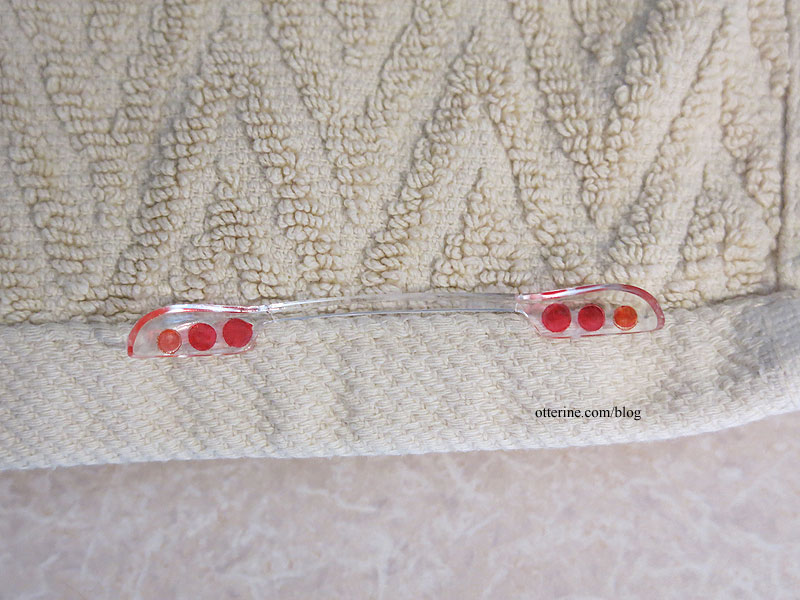
I painted the back of the piece with black acrylic. I used acrylic instead of enamels since I wasn’t able to figure out how to mask the outside well enough to prevent marring the finish. Acrylics clean up easily, and this back side will not be seen.
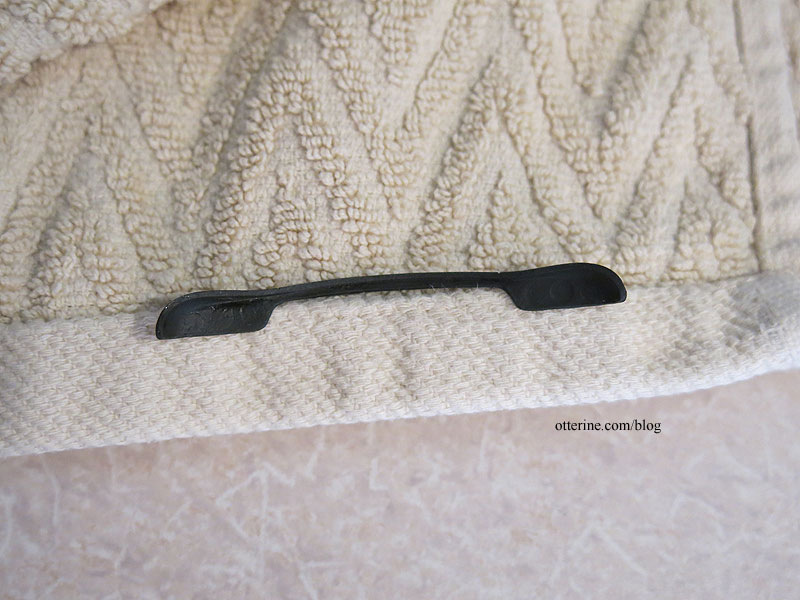
The exterior surface remains glossy, and the color fills in the back. It looks great like this, but the masking is still in place.
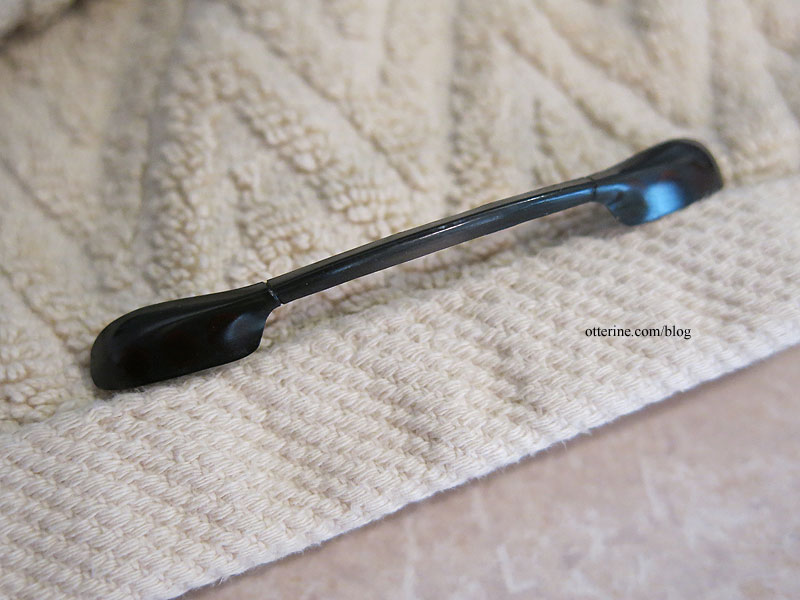
I removed the masking, and you can see how uneven the mask ended up being. Still better than I could have done free hand painting around the circles. I touched up the paint with a tiny brush as best I could (sorry, forgot to take a pic after touching up).
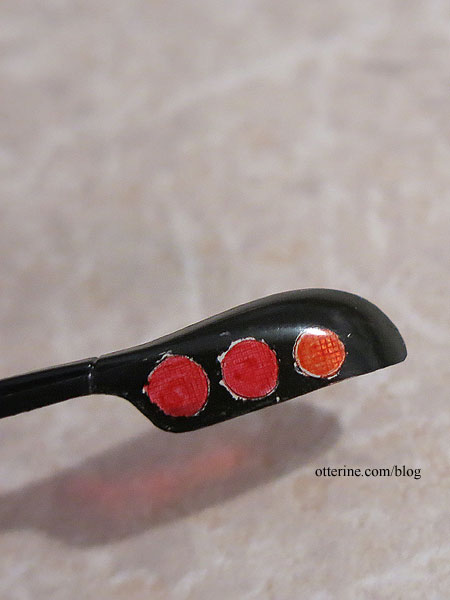
I am using 3V pico LEDs from Evan Designs. These are so wee! I lined up the cover piece with the back of the car to determine where to drill holes for the lights. I painted the area under the light covers silver.
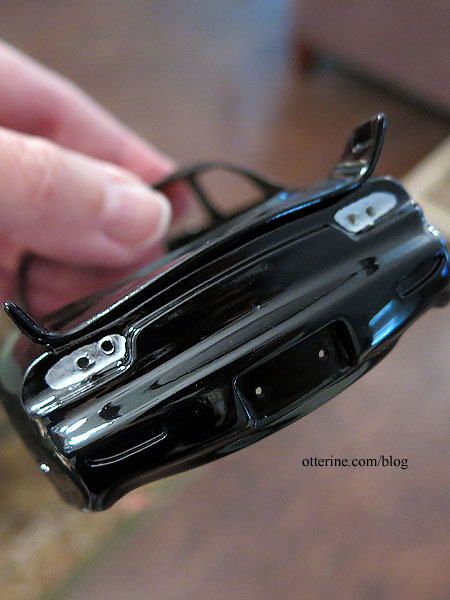
I pushed the pico lights into place and fastened with electrical tape on the inside.
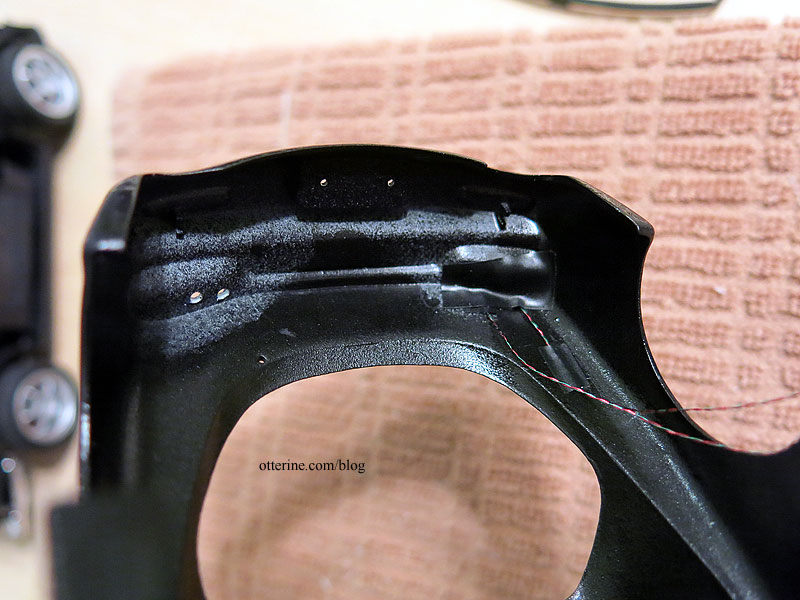
I don’t want to glue the plastic cover on just yet to limit the handling, but it looks like it will work well. :D
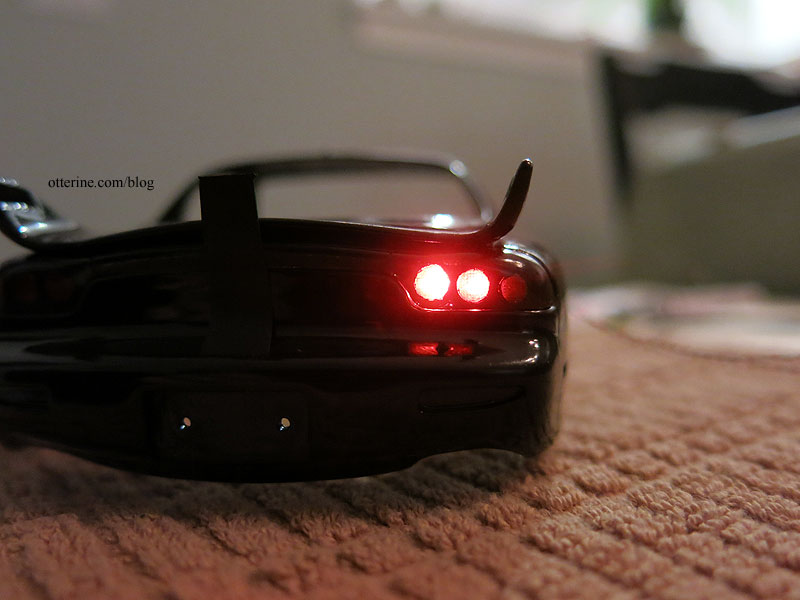
I didn’t put in lighting under the orange. Working turn signals are for another time. The headlights are up next.
Categories: Model Cars, Vehicles
October 20, 2018 | 0 commentsRX-7 in half scale – miscellaneous detailing
Continuing work on the RX-7 in half scale. When trying out new techniques, it’s nice to have spare parts to use so you don’t risk ruining the final parts. It doesn’t guarantee that you won’t mess up the final parts, unfortunately. But, it gives you practice that is invaluable.
Many cars have black edge detailing around the windows, and to paint those, you need to make a mask of the area. I use the process detailed in this video (starting at 1:10). I’m using Frog tape and painted with flat black spray paint instead of hand painting with bottled paint. Bottled paint goes on heavier and can wick under the tape whereas spray paint can be put on in light coats that stay put.
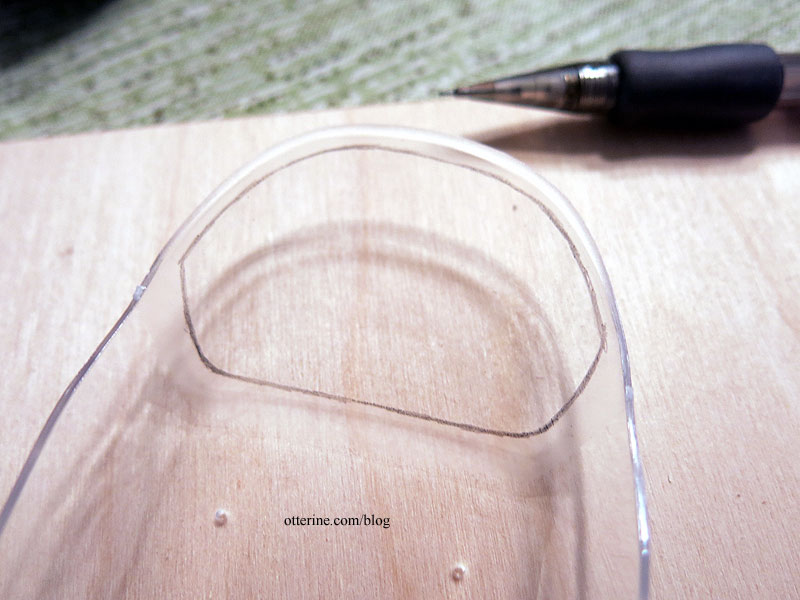
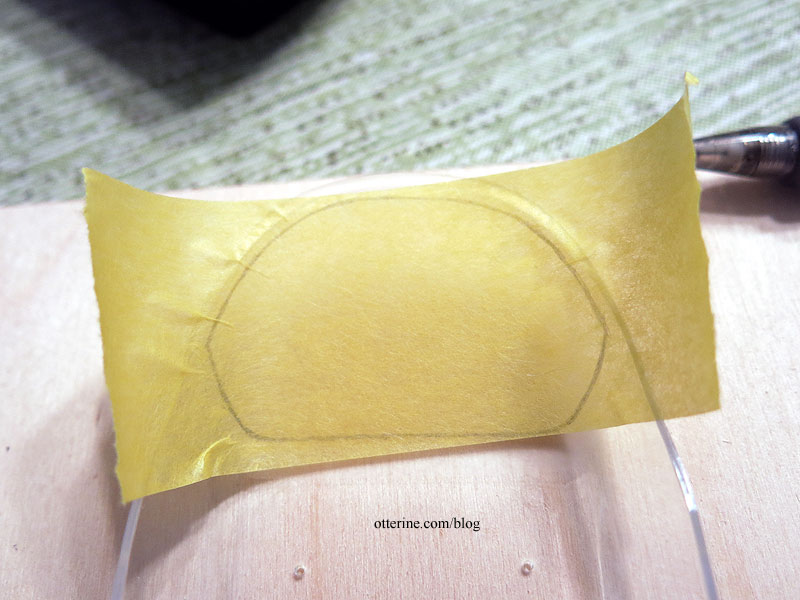
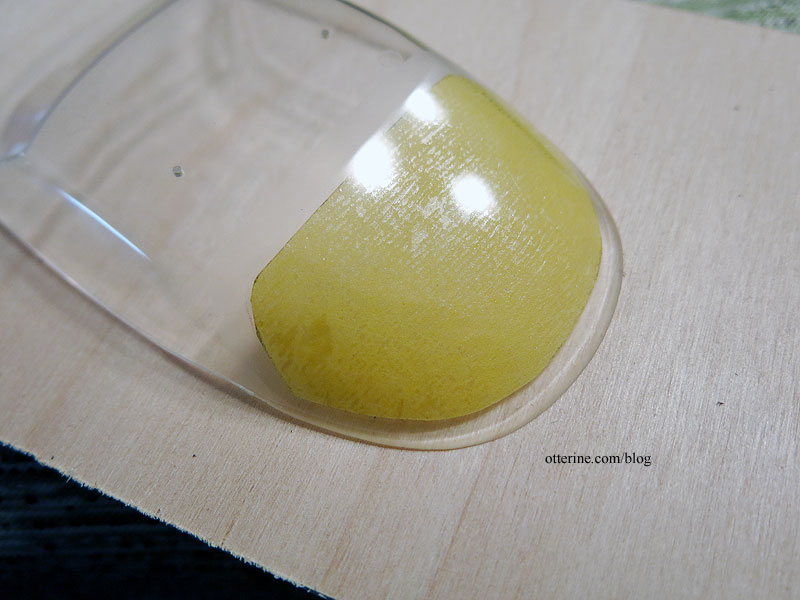
You have to get a good mask on the outside to prevent overspray on the “good” side.
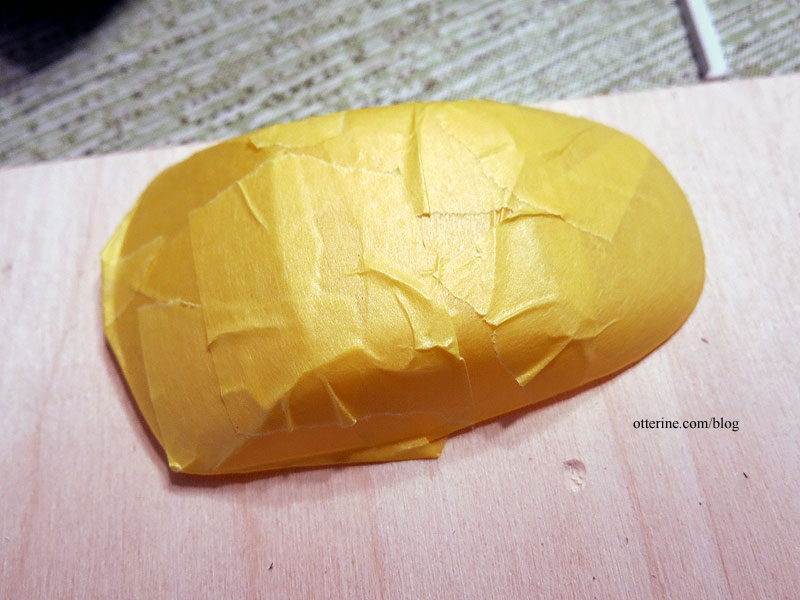
The small exposed area is where I sprayed the paint.
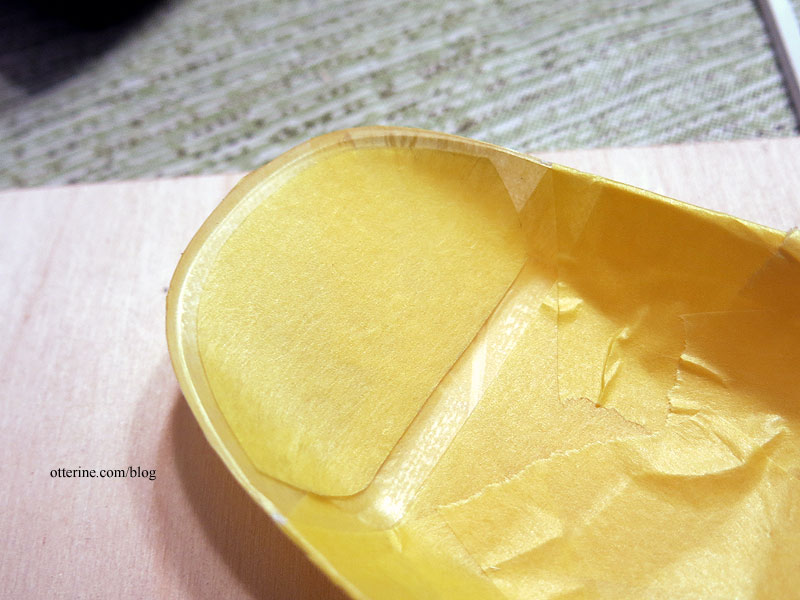
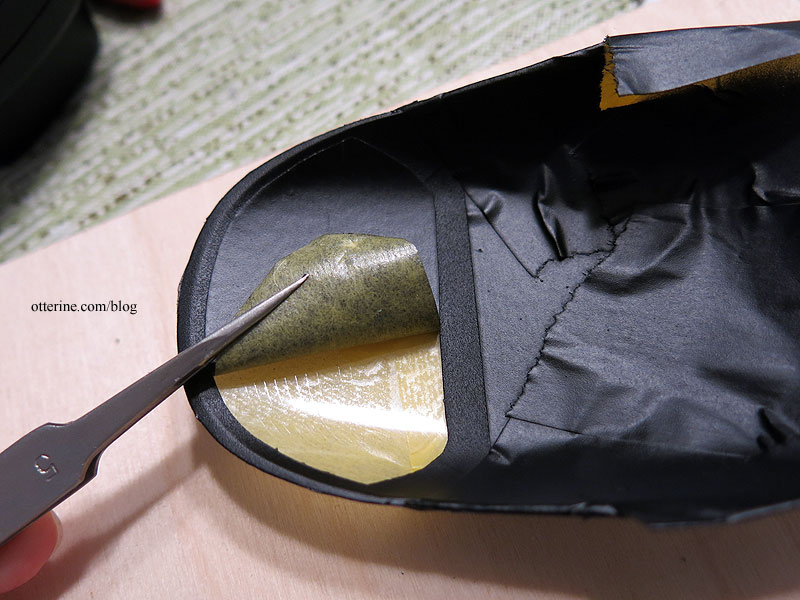
The trial worked well. Let’s hope I can replicate the results on the final piece.
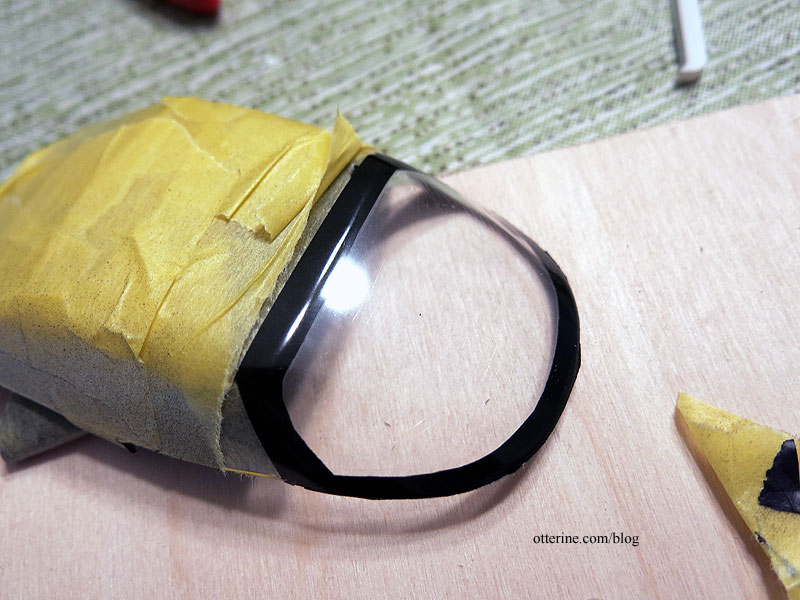
I wanted to try tinting the windows as well. I used Tamiya Smoke.
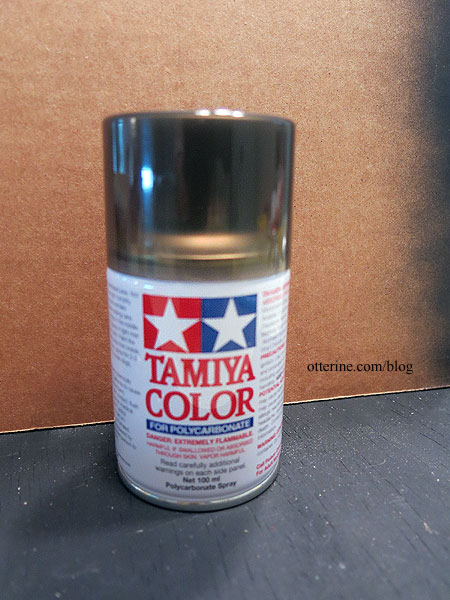
This paint needs to put on sparingly and from a distance on the underside of the window (again you mask the outside to protect the surface). You build up the layers to get the level of tint you want while the outside stays glossy like glass. While the effect is nice, I think it will block too much of the interior detailing. You can’t easily discern the tweezers through the tint in the photo below.
This will be a great resource for dirty windows on other projects, though. :] I usually just use overspray, but this was easier to control.
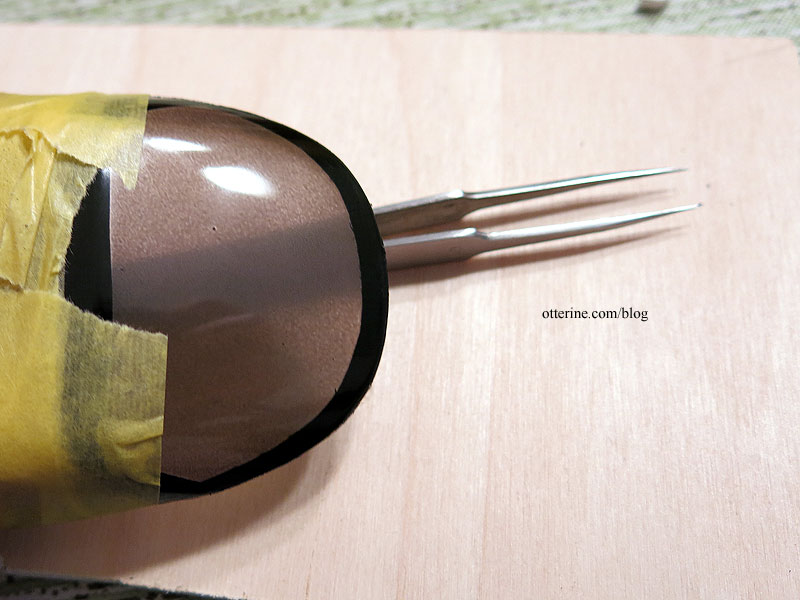
The side mirrors are molded separately from the body, which makes it easier to get a good finish, but there are mold lines and sprue connections that need to be cleaned before painting.
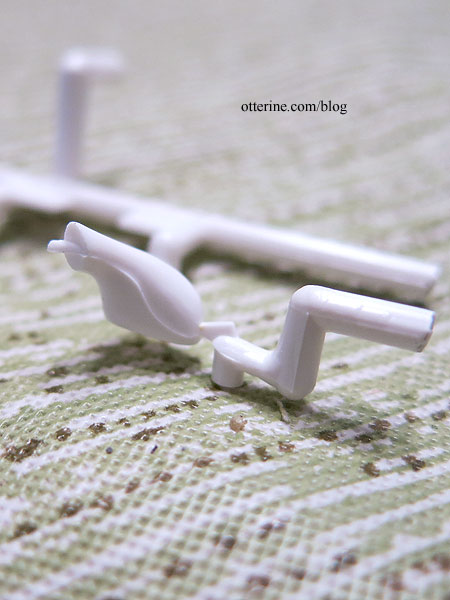
That also makes it difficult to paint since you have to hold the parts somehow while painting. Here is one mirror after removing the lines and nubs.
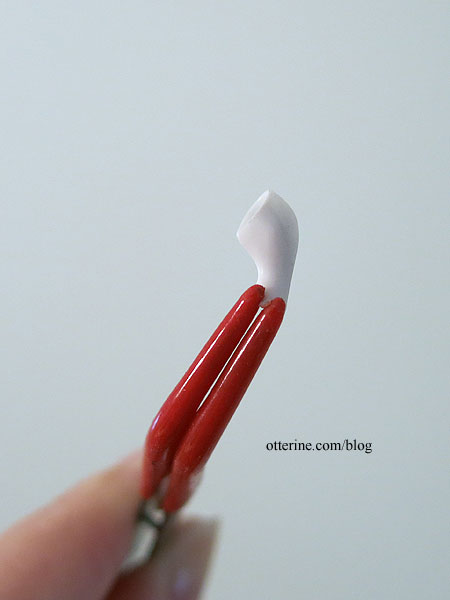
I put tape on the end of a bamboo skewer to hold each mirror. Since there will be a simulated mirror in each one, it’s okay to not paint the interiors.
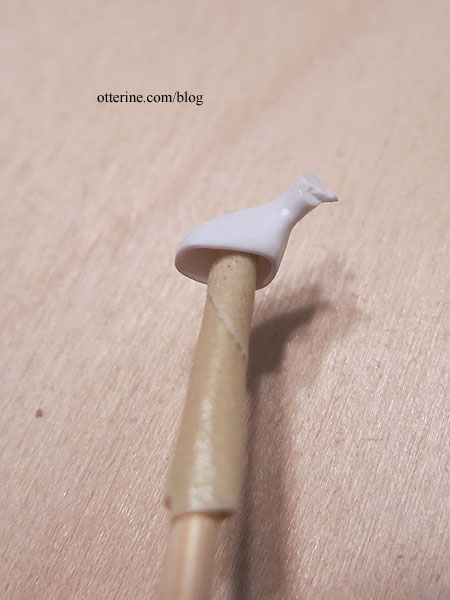
The spoiler top was also problematic in finishing since there is no way to hold it while painting. Well, you can hold it, but putting it down while it dries is the main issue. I masked a clamp and held the part by the ends where it will be glued to the spoiler base already on the car. It was the easiest way to hold the part without ruining the clamp in the process.
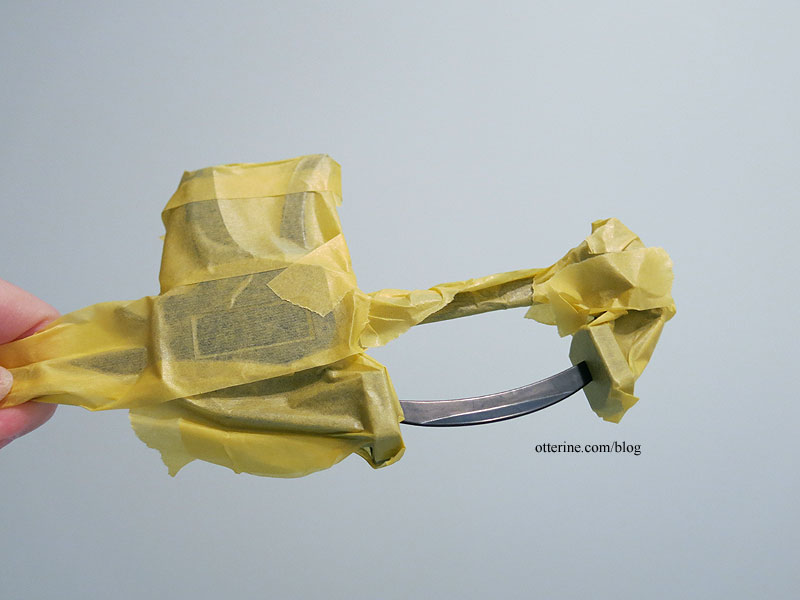
Bits and pieces get the job done….
Categories: Model Cars, Vehicles
October 14, 2018 | 0 commentsRX-7 in half scale – body paint
Continuing work on the RX-7 in half scale. For the base coat, I’ve used Model Master Gray Sandable Lacquer Primer Spray (yeah, that’s a mouthful). :D
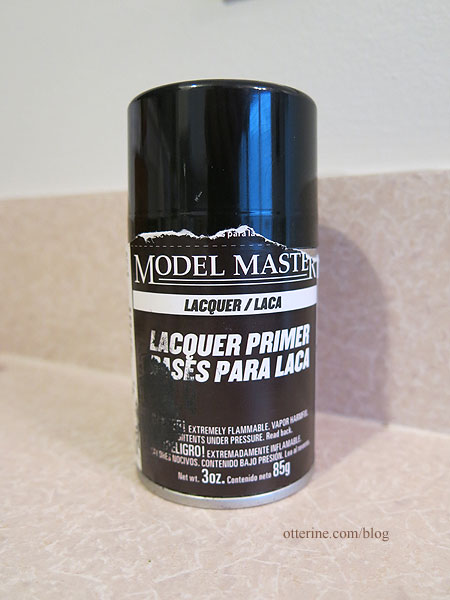
I then wet-sanded using the Micro-Mesh Sanding Sheets in 4000, 6000, 8000 and 12,000 to get as smooth a surface as possible (as an Amazon Associate, I earn from qualifying purchases).
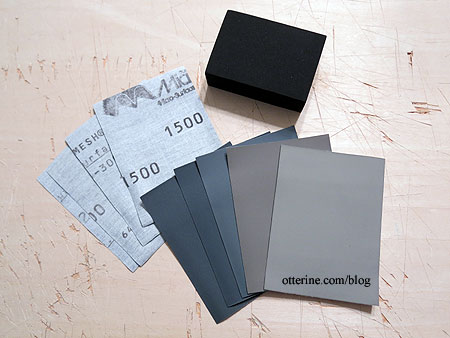
The better the primed surface, the better the top coat. You can see the sheen in the reflection.
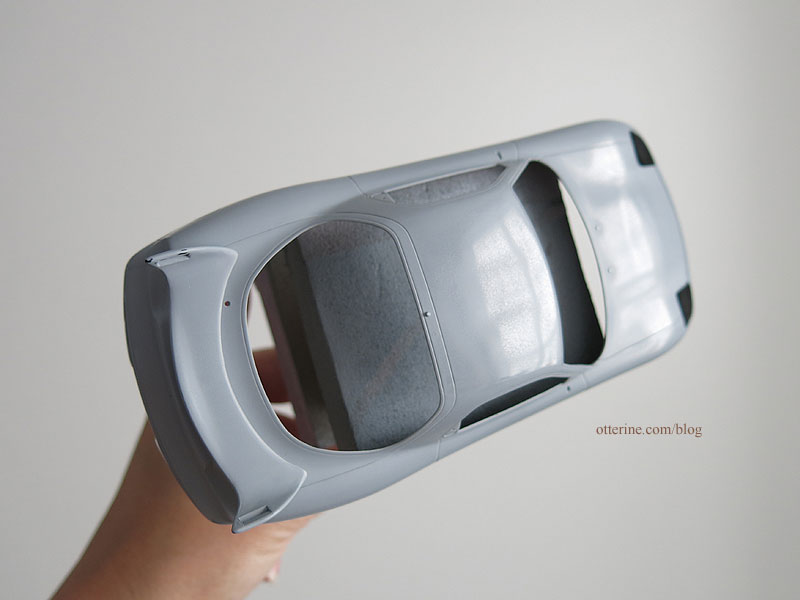
My makeshift holder is made from scraps of builders foam.
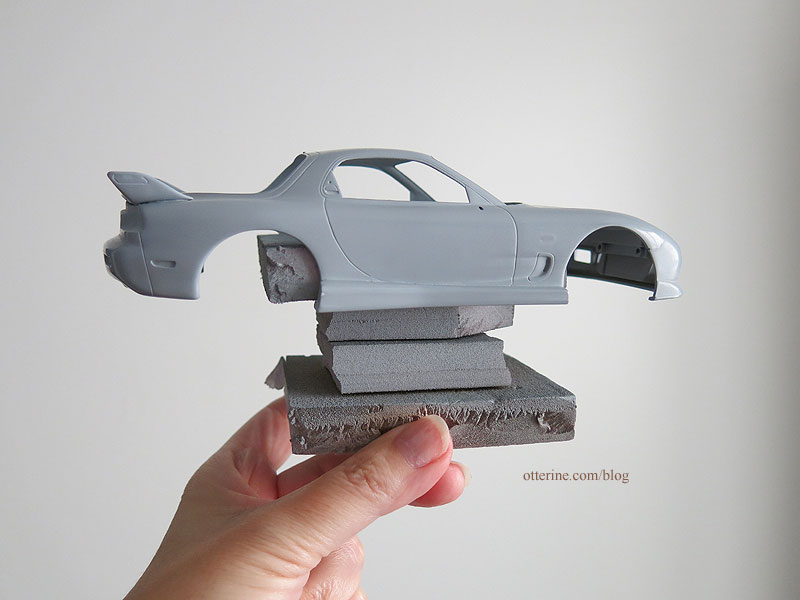
My new tattoo. Looks like I need a longer glove when spray painting. :D
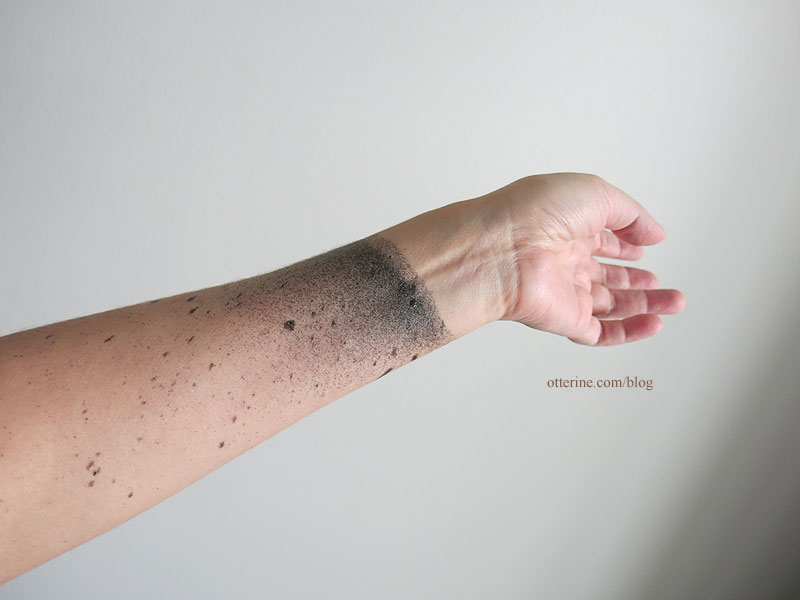
The paint is 95% perfect, which is about the best you can hope for most of the time. Woot! Once it has set, I’ll see if I want to attempt to buff out the few dust particles that invariably get caught in the finish. Sometimes messing with it makes it worse. So far, so good, though. :] The side skirts and new wing look pretty seamless now, which is what I had hoped.
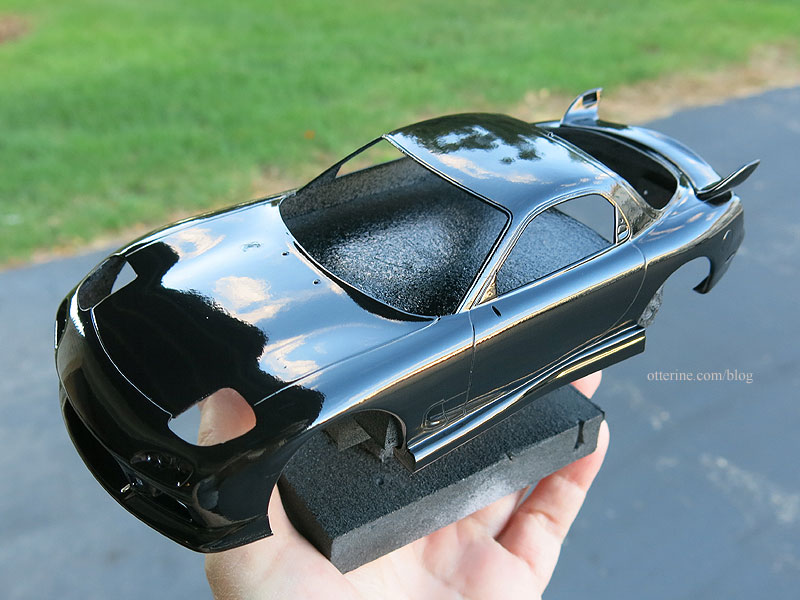
Categories: Model Cars, Vehicles
October 4, 2018 | 0 commentsRX-7 in half scale – interior
Continuing work on the RX-7 in half scale. The interior is fairly straightforward, just tedious and time-consuming. The C-West kit comes with both left- and right-hand driver dashboards, which is fun. However, the seats are lacking. The Tamiya kit has seats that are molded as one piece – much cleaner than trying to get fronts and backs to match seamlessly. So, I swapped out the seats.

Decal placement takes a steady hand and some patience, though there is one thing the instructions don’t mention. Each one has a halo around the actual image that should be removed as close as possible. This is especially important for fitting into depressions made for the decals, such as the dashboard.

If you don’t remove the halos, the decals will simply not fit the spaces. Those three on the left are super tiny.

I glued the various interior pieces…

…and glued the bucket to the chassis. :D

Categories: Model Cars, Vehicles
September 28, 2018 | 0 commentsRX-7 in half scale – wheels and warping
Continuing work on the RX-7 in half scale. The Tamiya kit has wider wheels and tires, which look sportier, so I tested to see if I could put them on the C-West kit. Nope. They stick out past the fenders.

The C-West kit comes with both gold and silver wheels. I planned to use the silver ones, but the tires are loose on the wheels – they just fall right off. Oy. The gold ones fit perfectly, of course. This is what I mean when I say getting one kit to fit properly is hard, let alone mixing more than one. Even the parts provided in a single kit don’t fit at times. =shakes head=

I tried wrapping one of the silver wheels with electrical tape, and if I was set on this design, it could work in a pinch. It’s not the cleanest solution from the back, but up front it’s not too noticeable to the naked eye.

So, on to painting the gold wheels using Model Master Metalizer Lacquer in Aluminum Plate. The initial finish is light matte silver. Once you buff it with a paper towel, it gets all shiny. :D
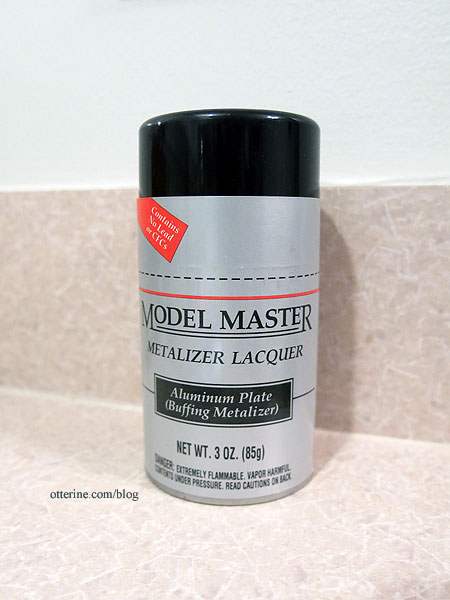
I then sealed with Model Master Metalizer Sealer.

Much better. All four wheels roll well, and the front ones turn from side to side.

Of course, once I got the wheels on, I could see that the main body piece was warped leaving one tire roughly 1/8″ up in the air. Oy. I heated the plastic along the warp line using the hot setting on my hair dryer, stretched the plastic past the point of being level, and taped it to an mdf board to cool. I’ll give it a looksee tomorrow and see if it needs more. If the heat doesn’t fix the issue, or gets it at least close to level, there are small weights I can add to the empty spaces inside – one good thing about not having an open engine compartment.

Categories: Model Cars, Vehicles
September 26, 2018 | 0 comments
NOTE: All content on otterine.com is copyrighted and may not be reproduced in part or in whole. It takes a lot of time and effort to write and photograph for my blog. Please ask permission before reproducing any of my content. (More on copyright)



